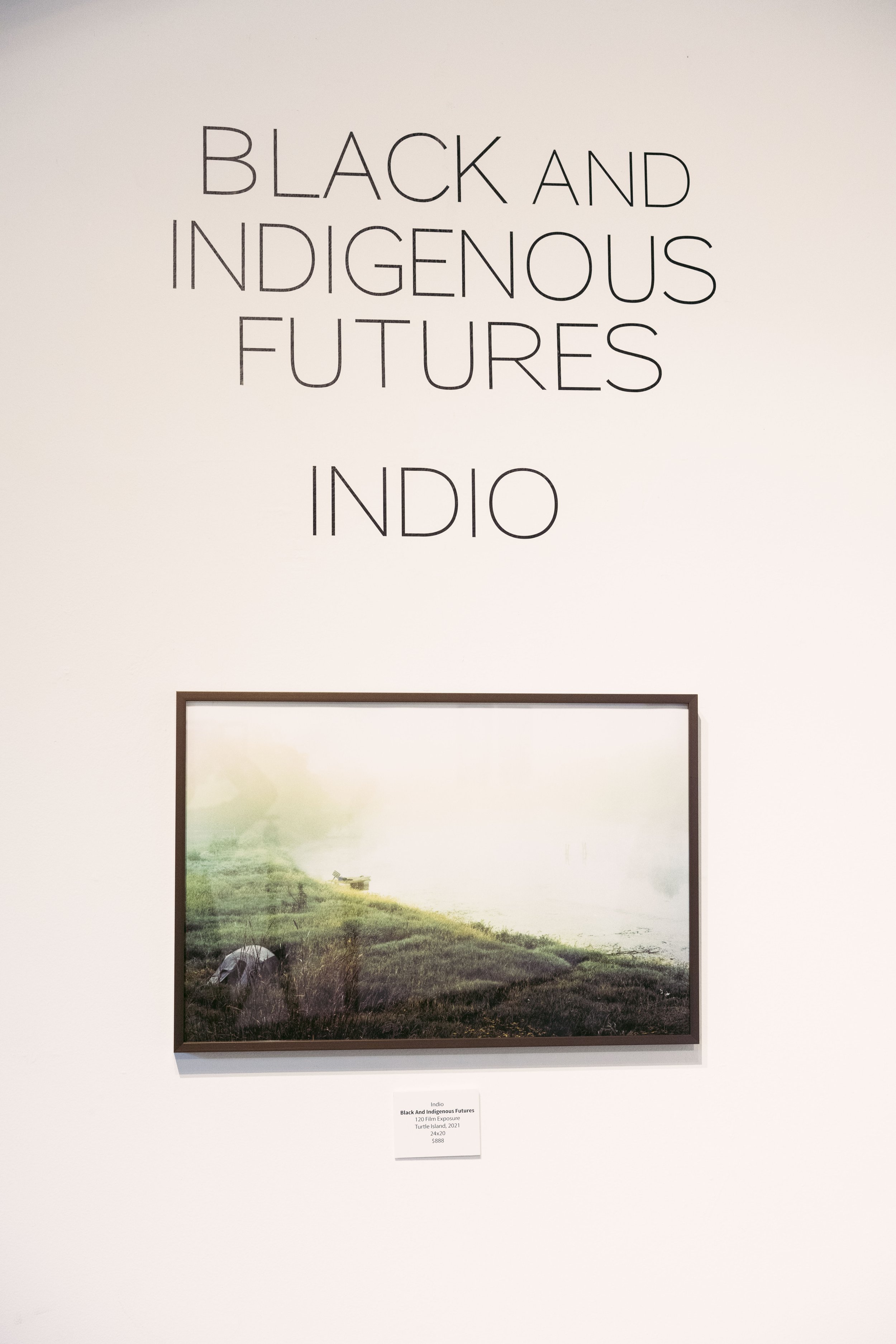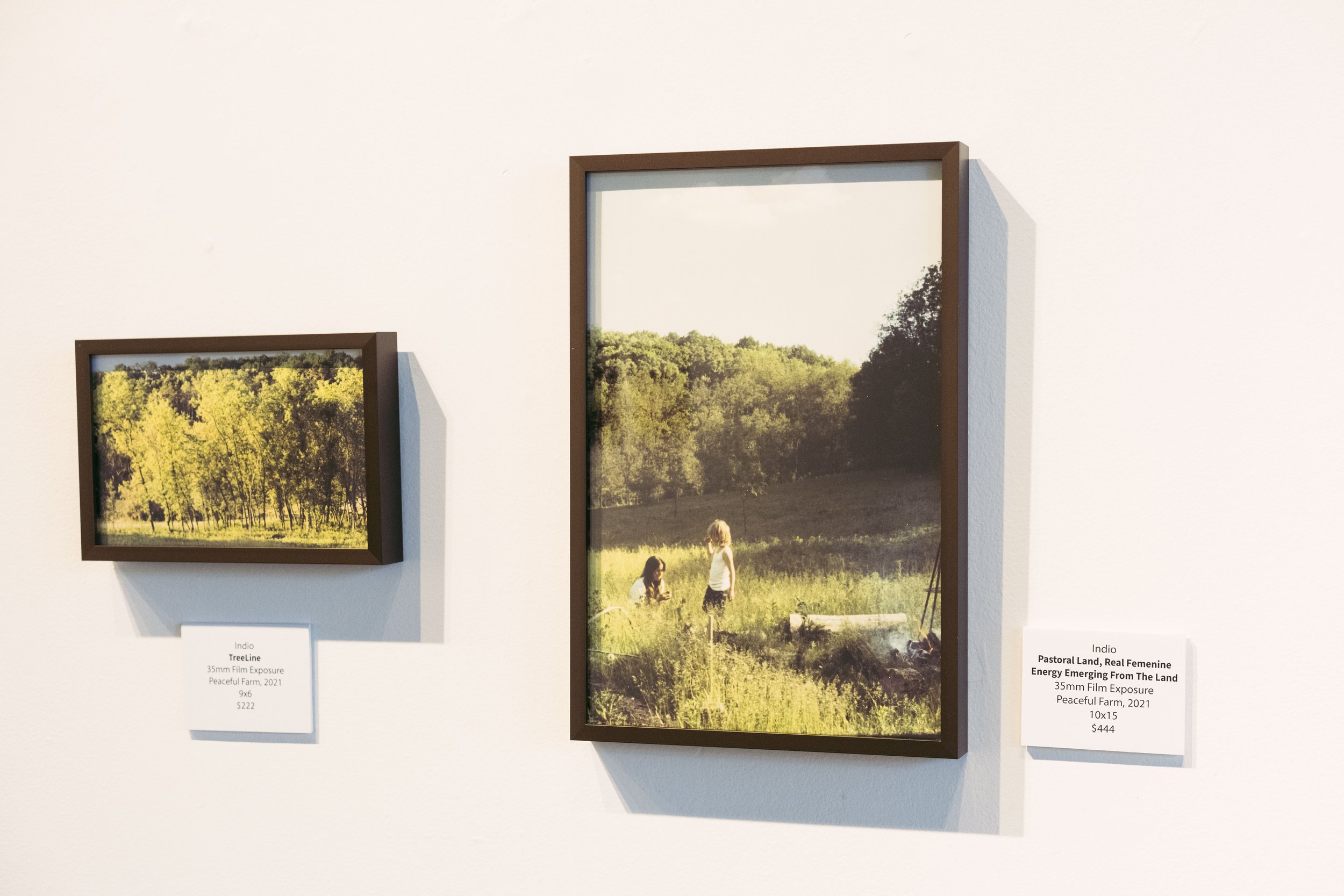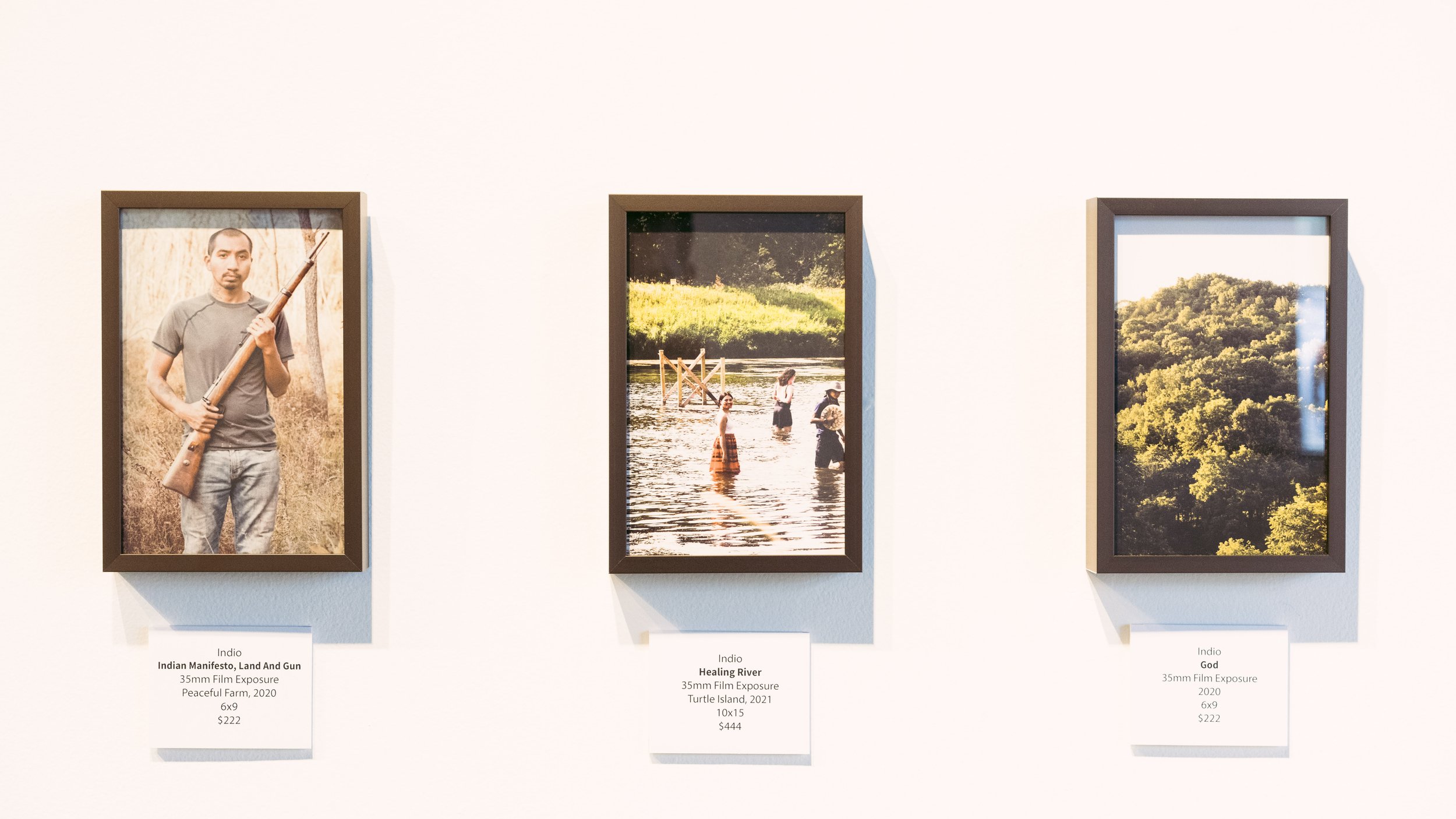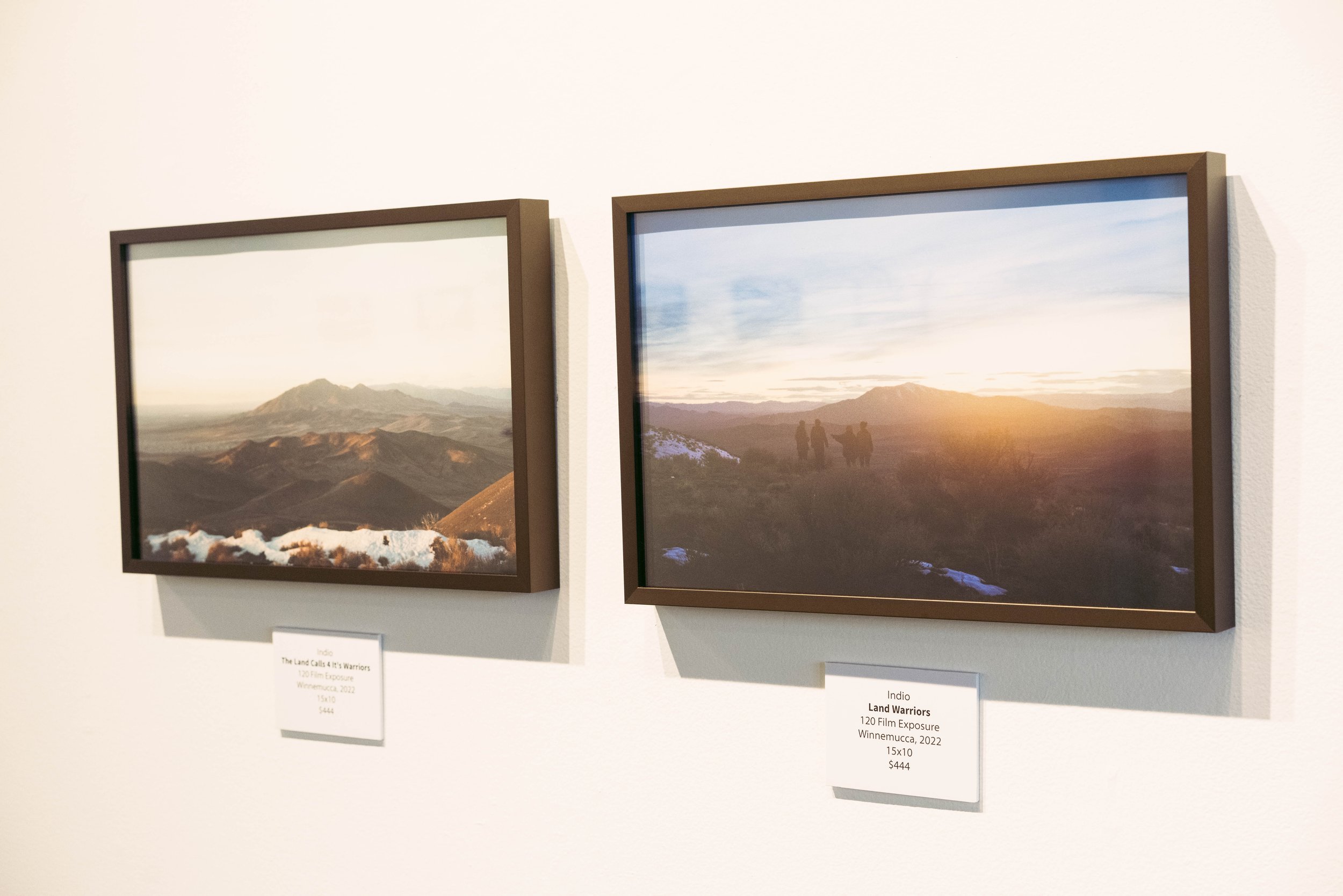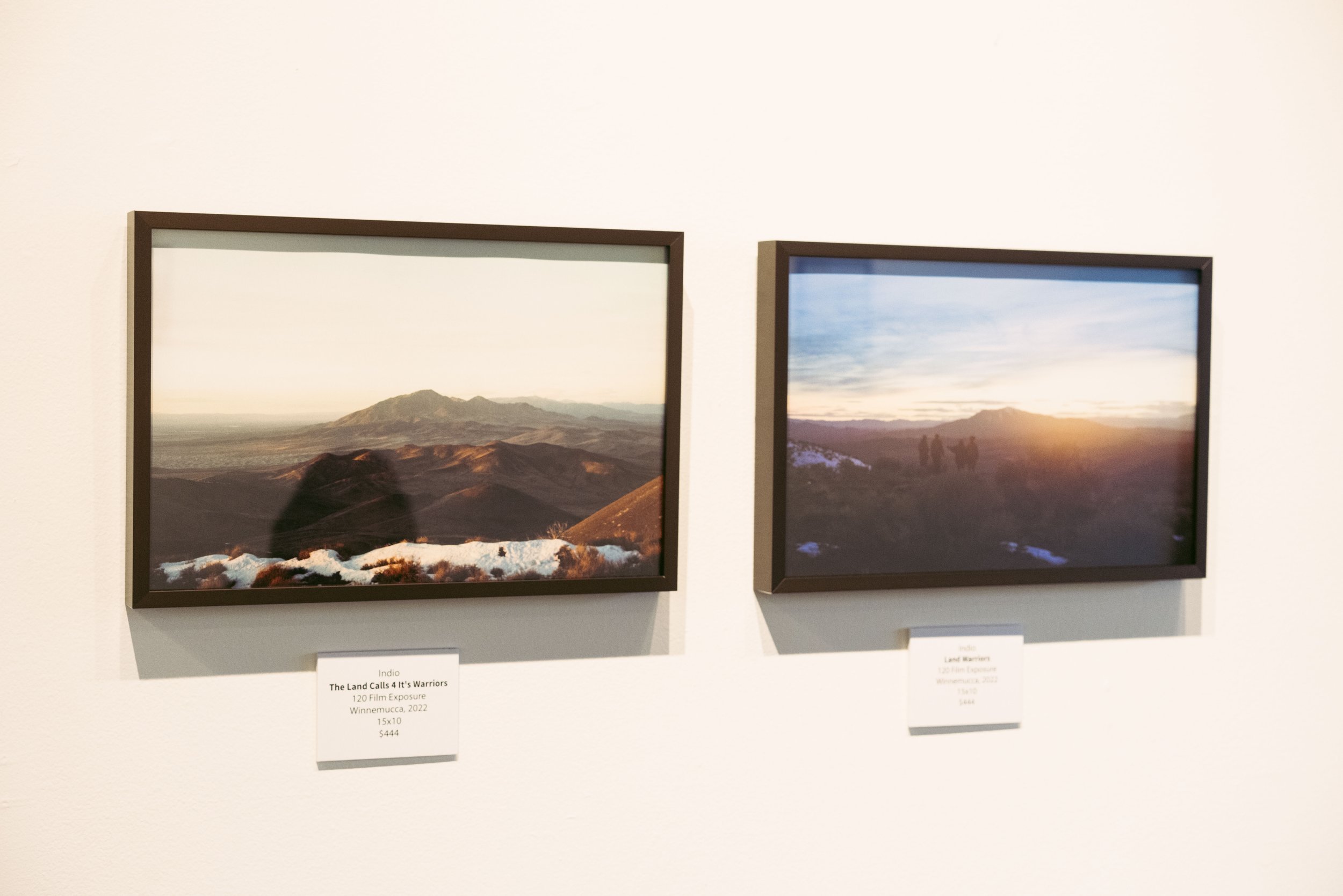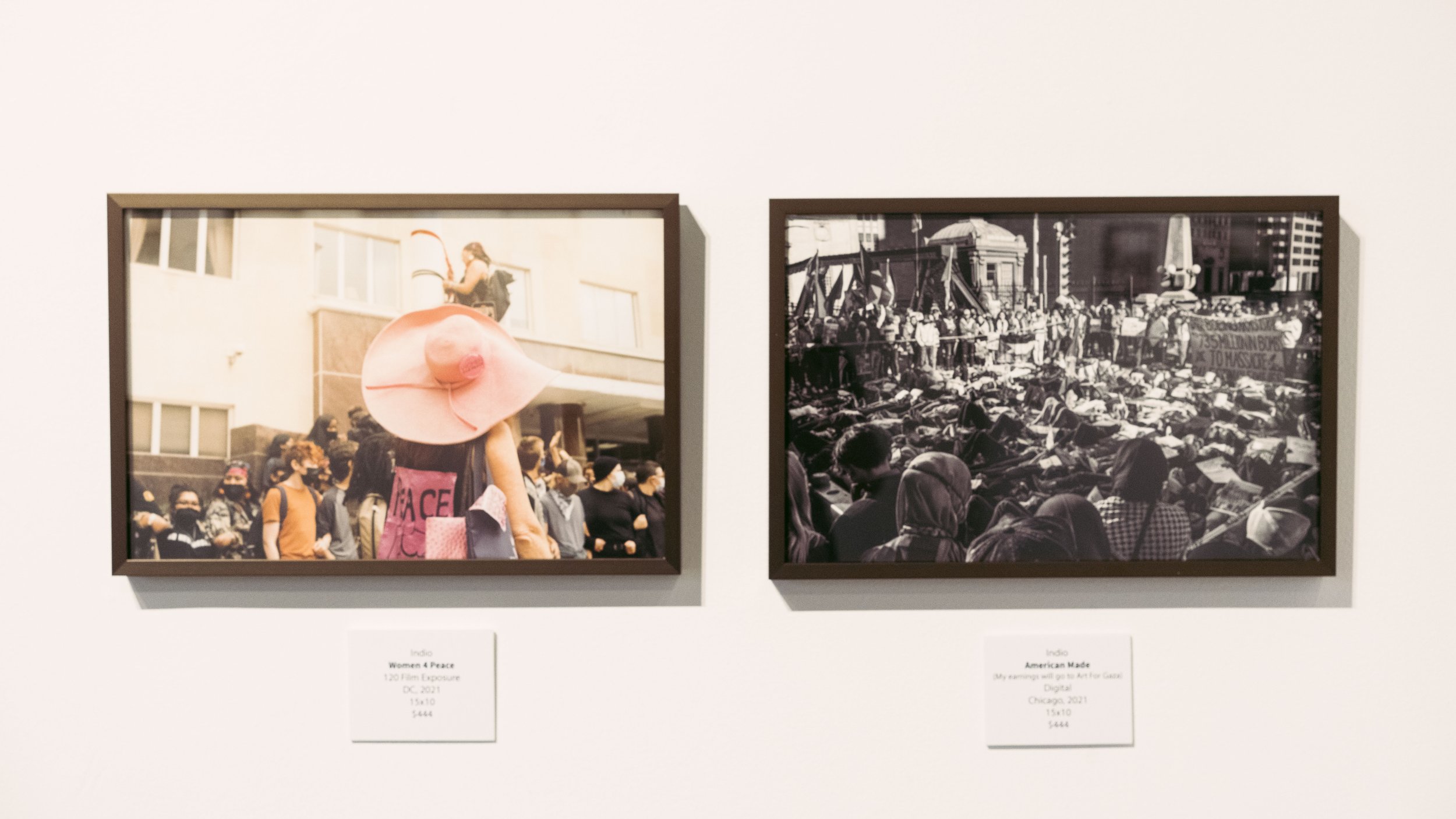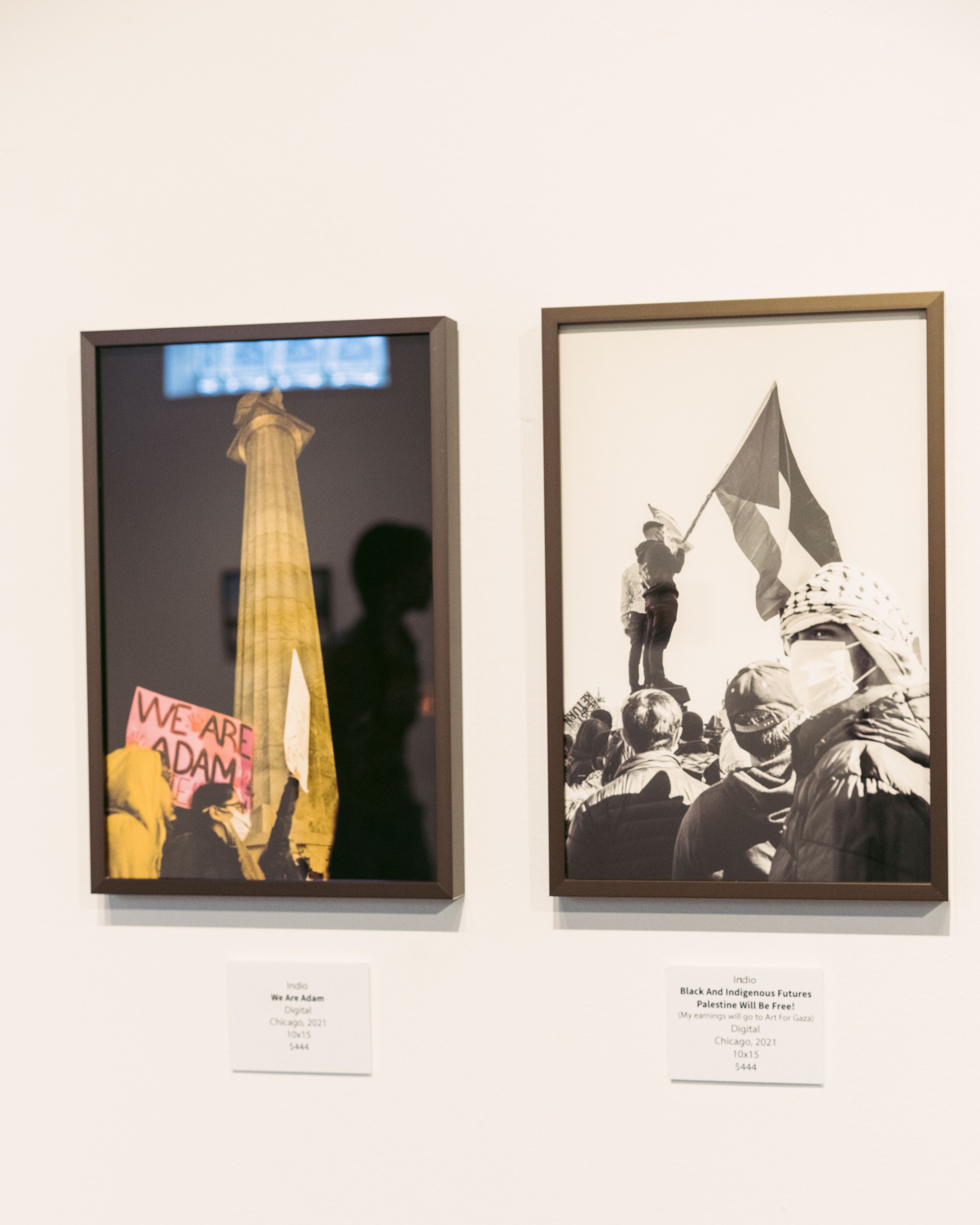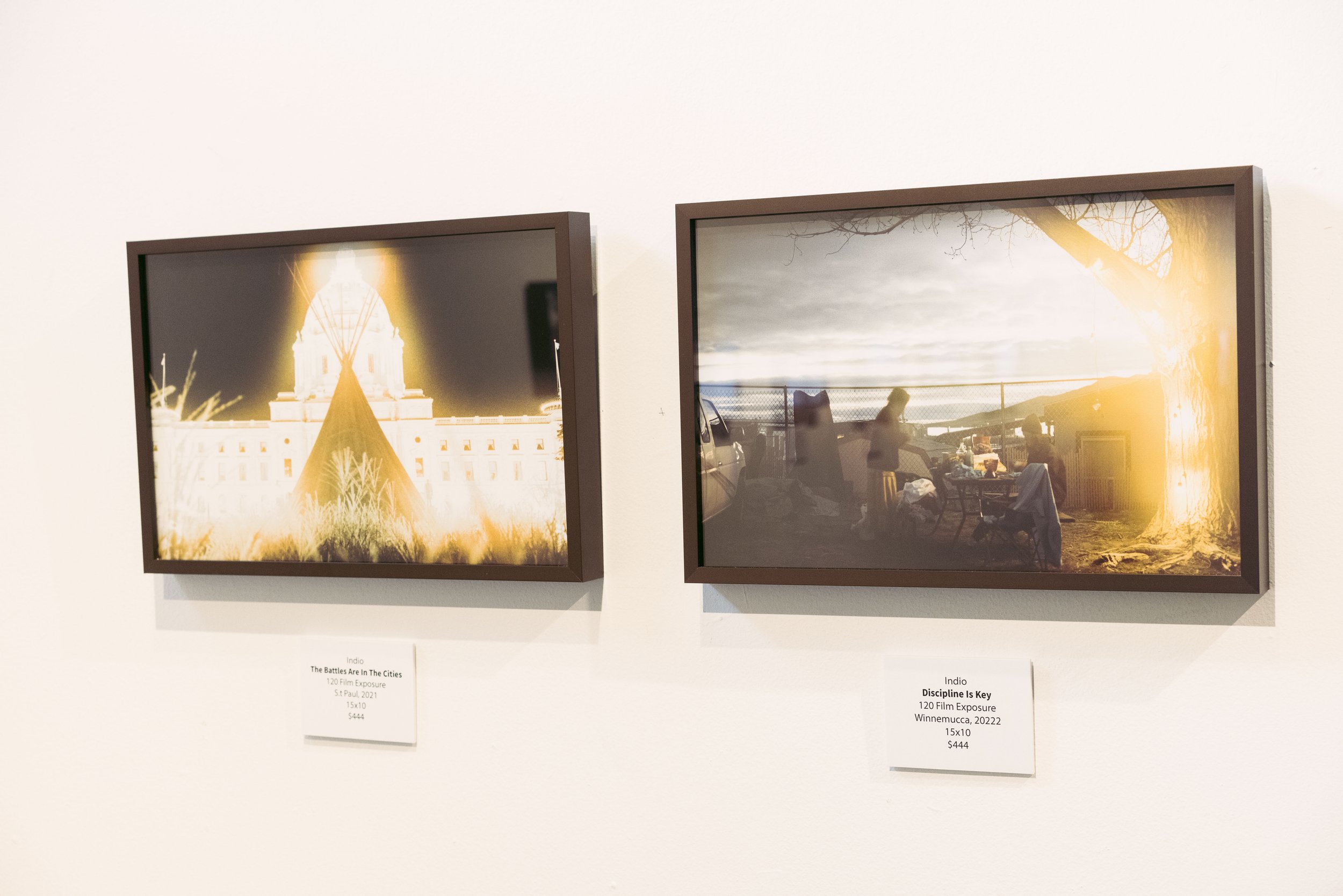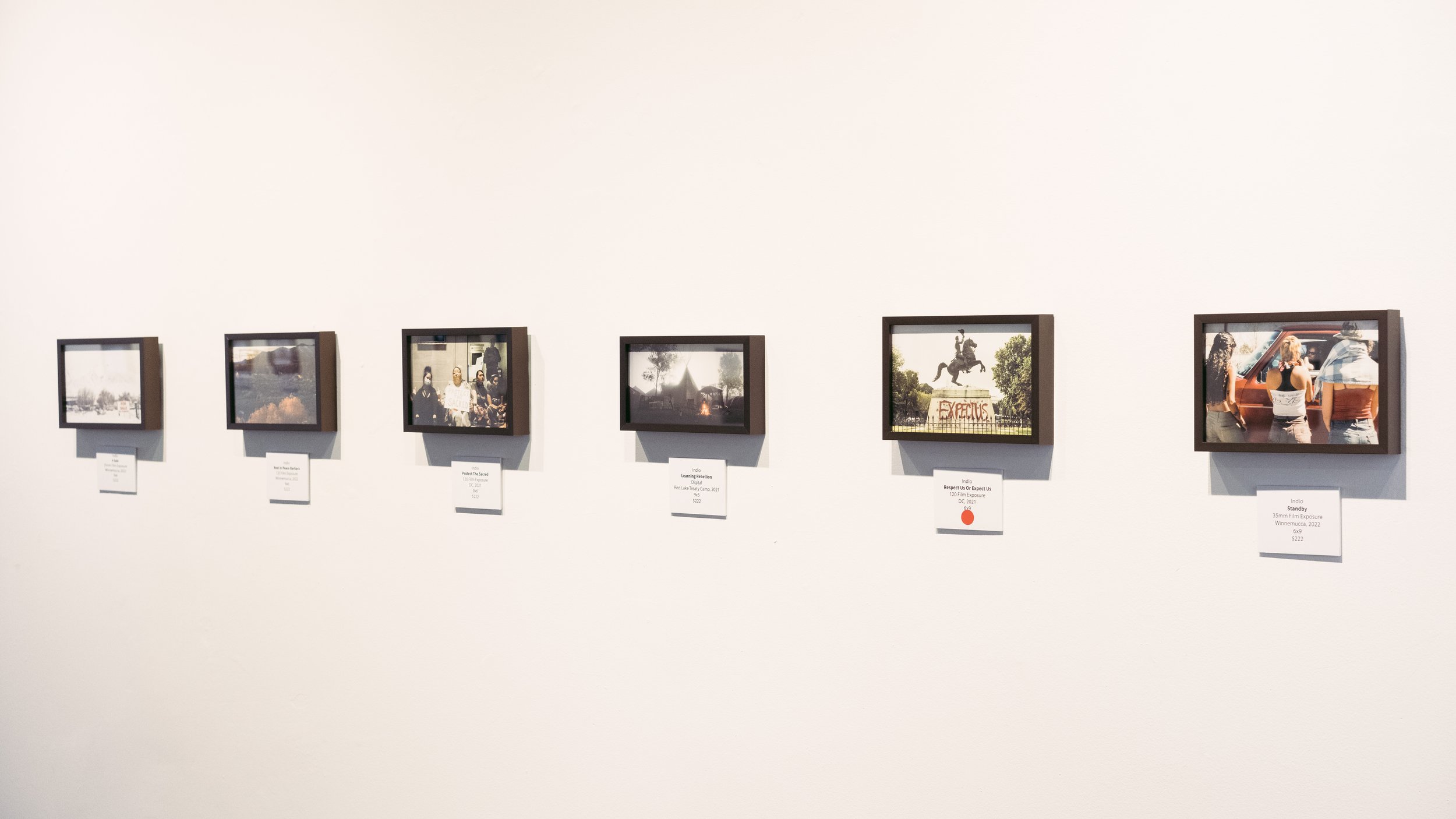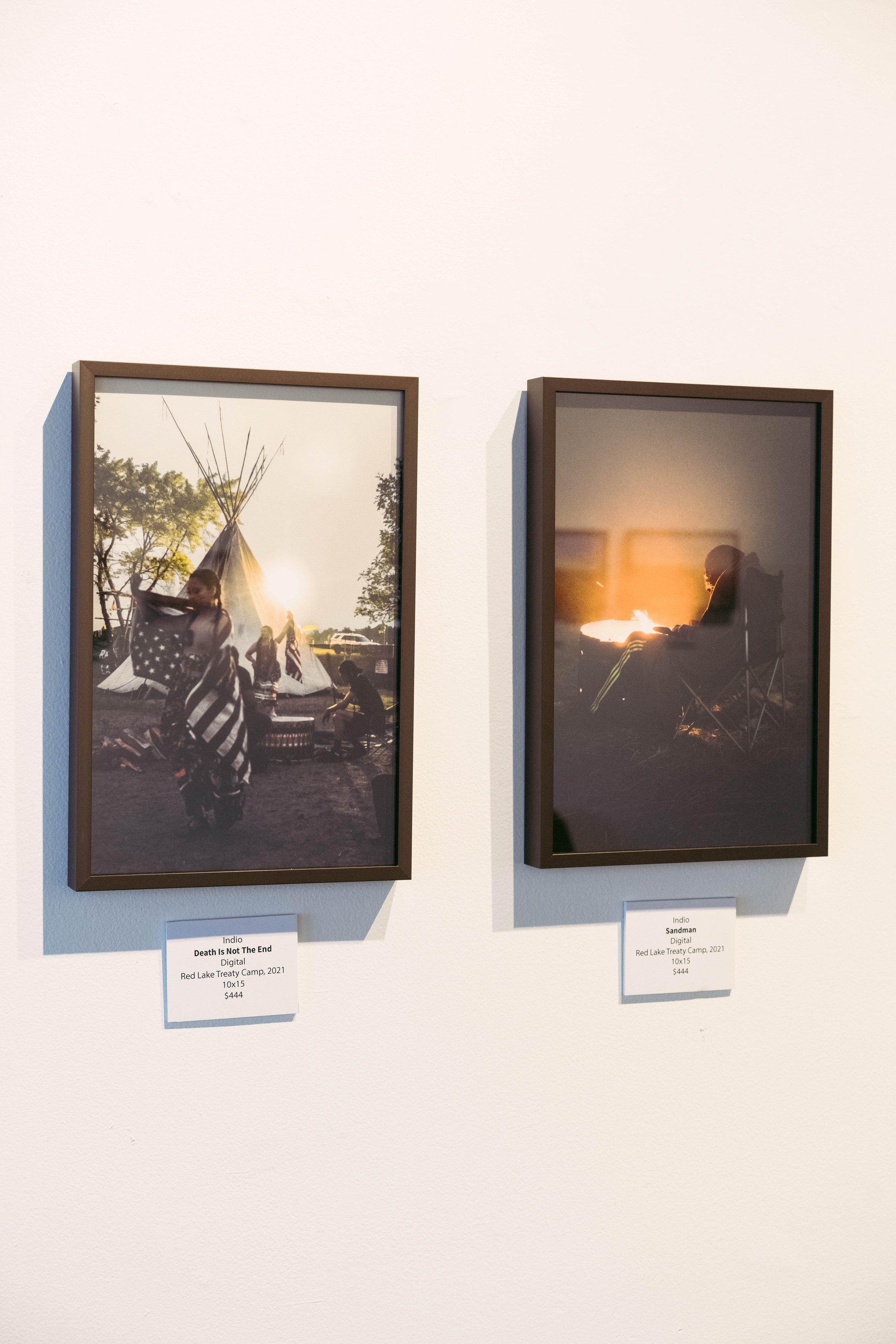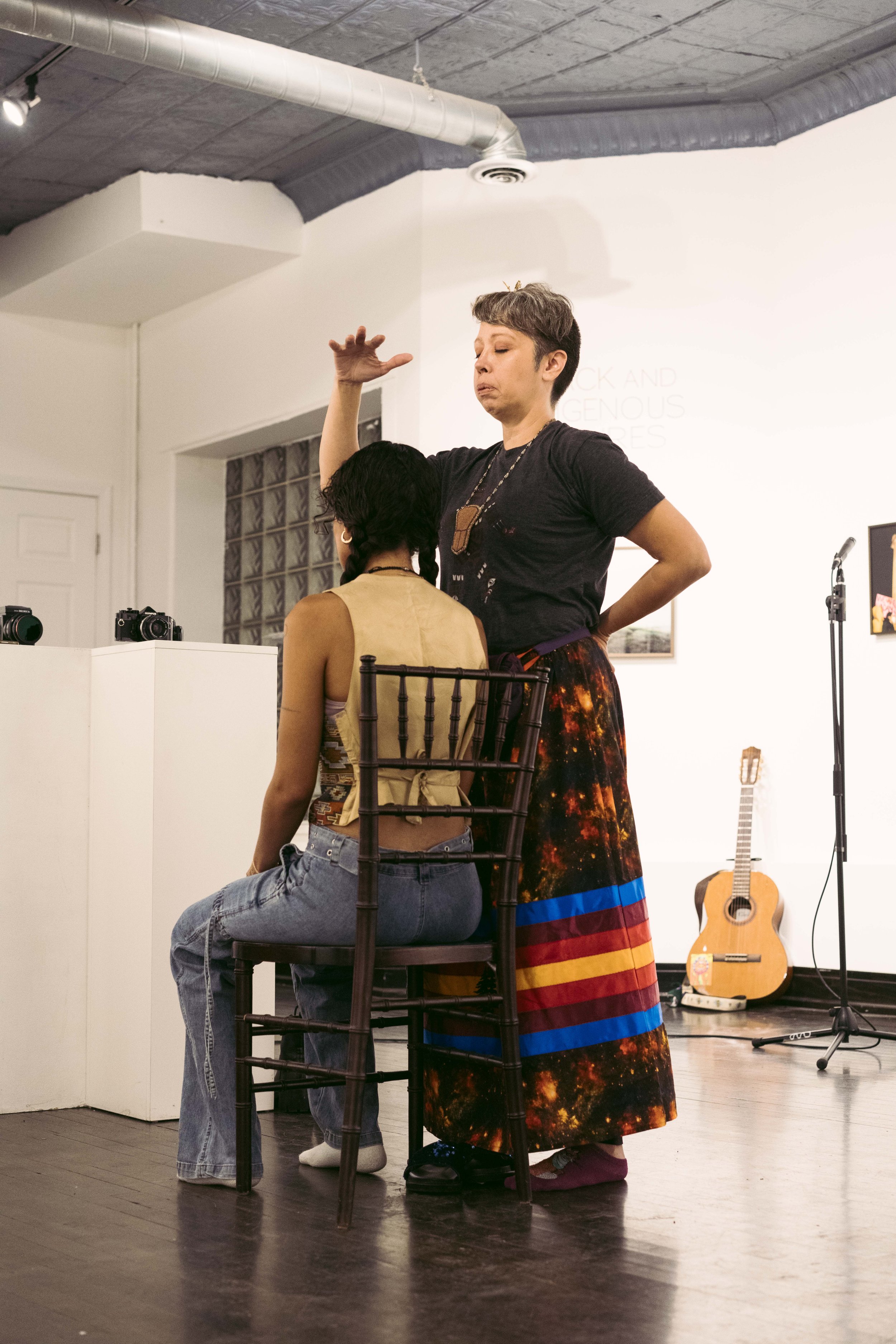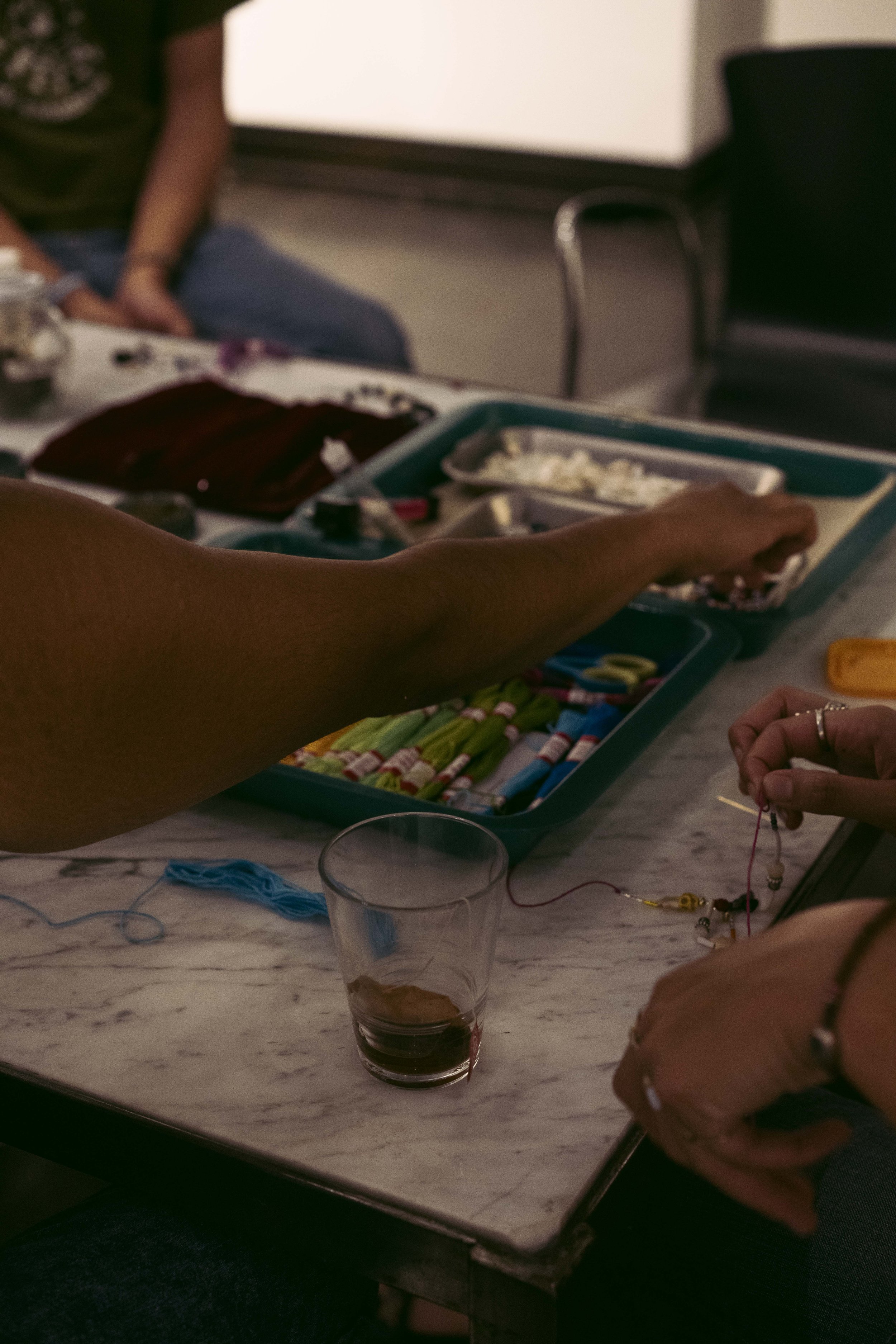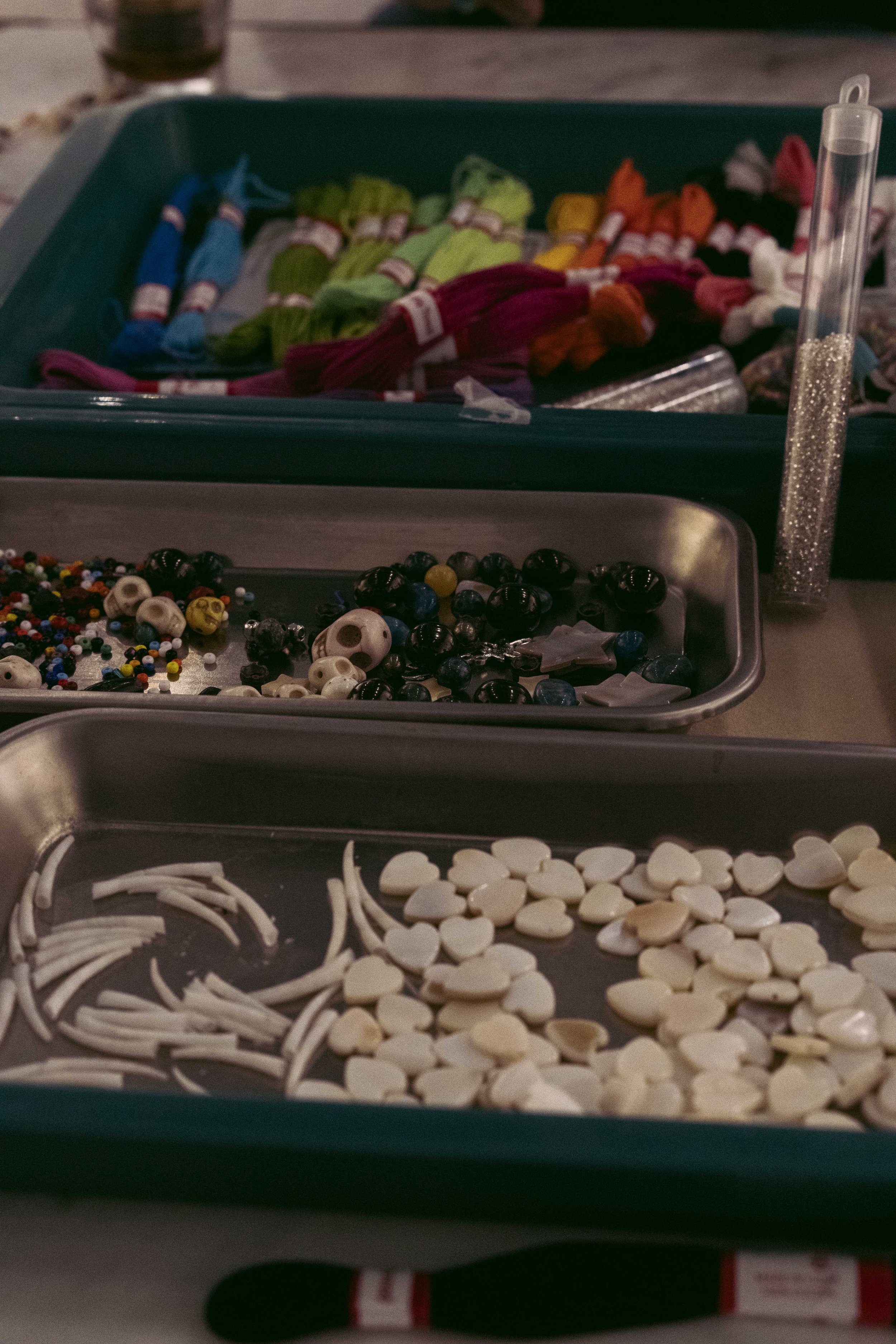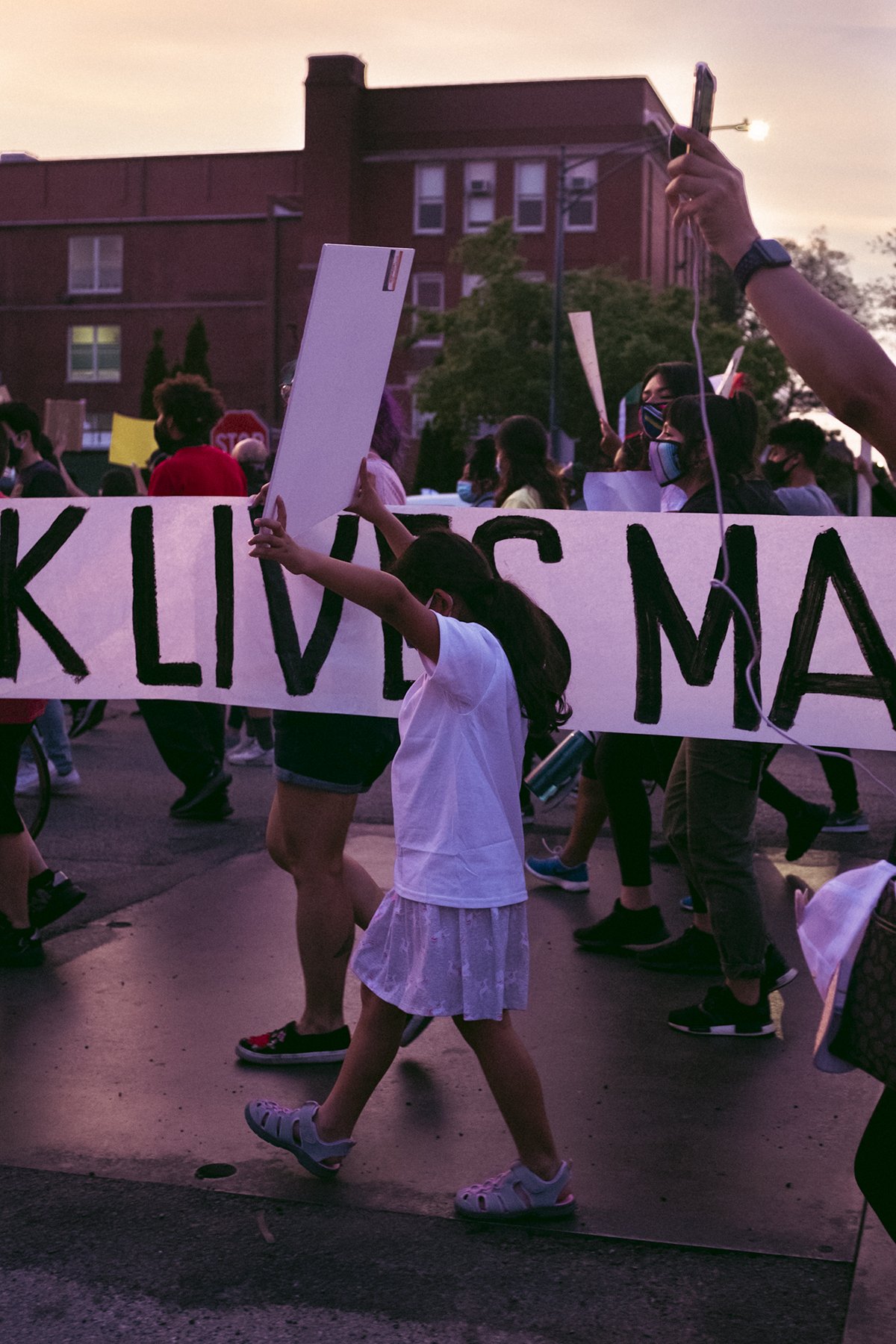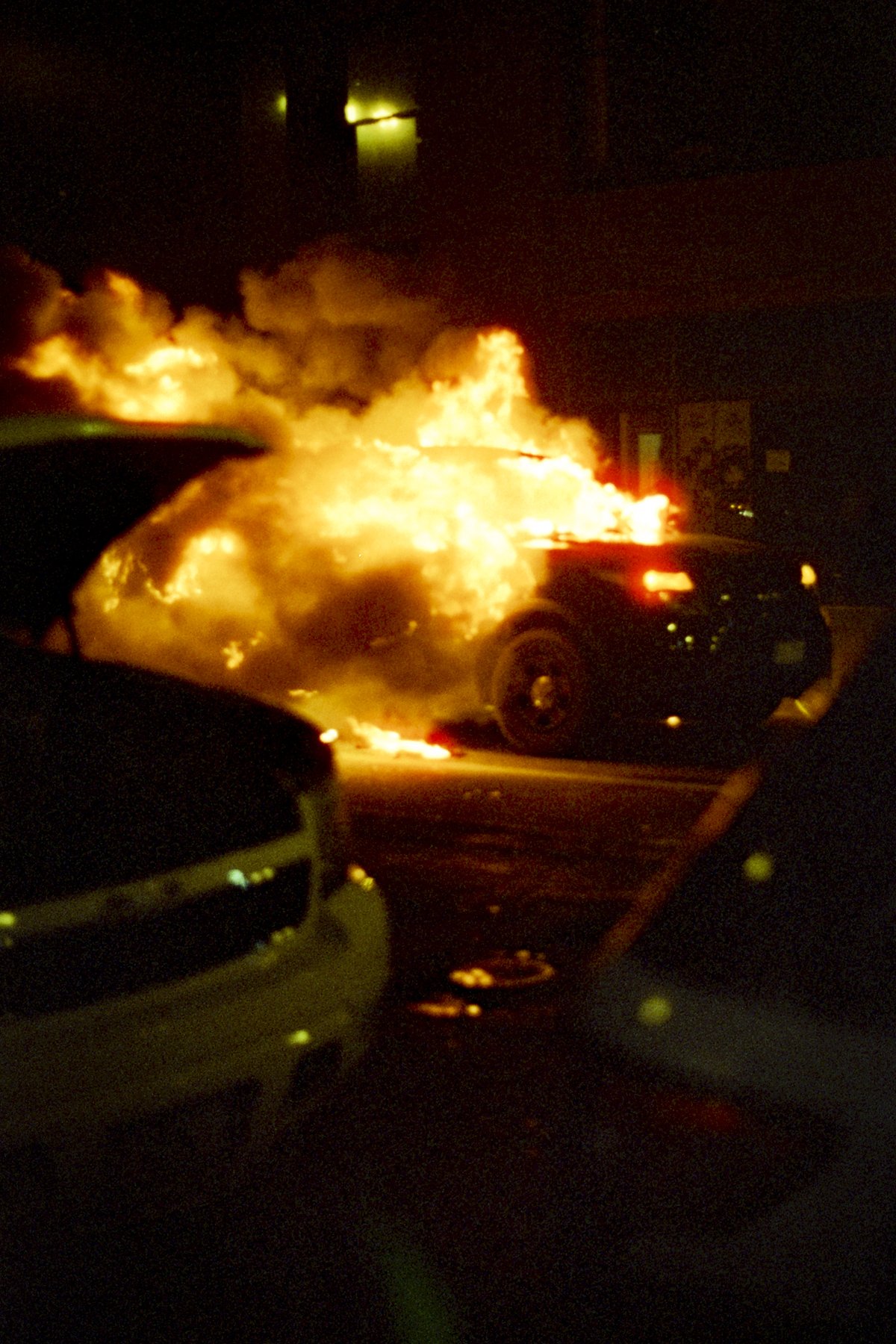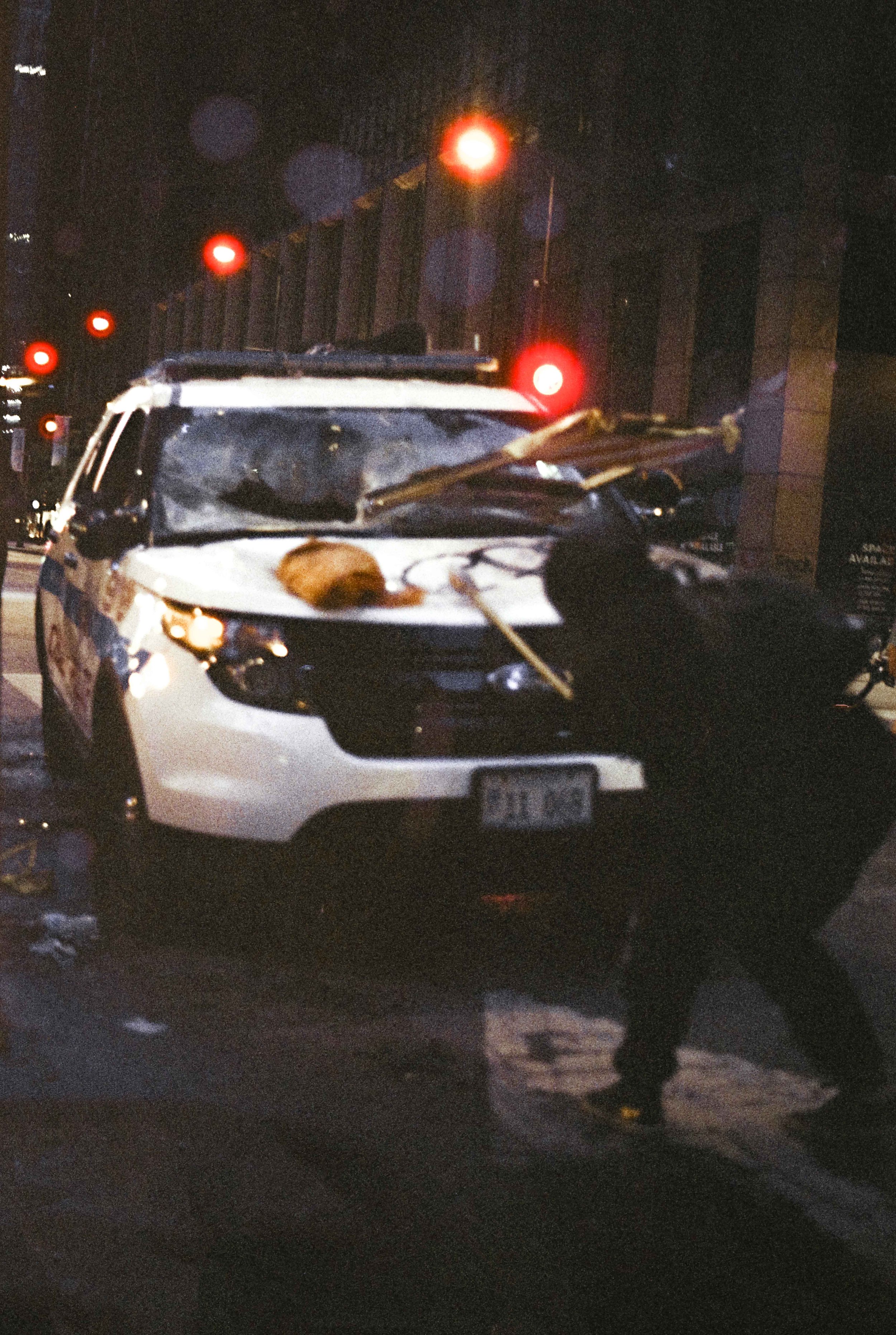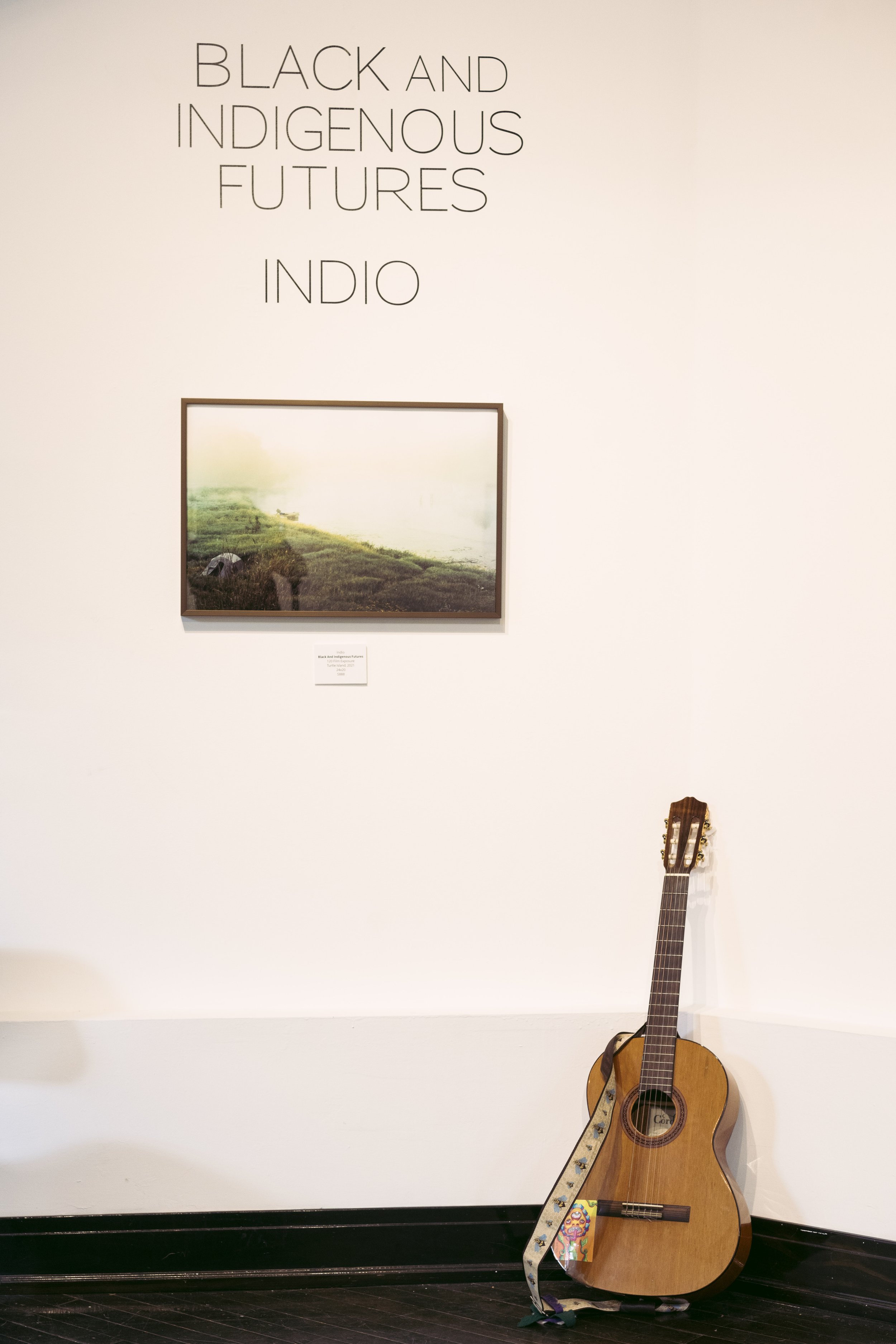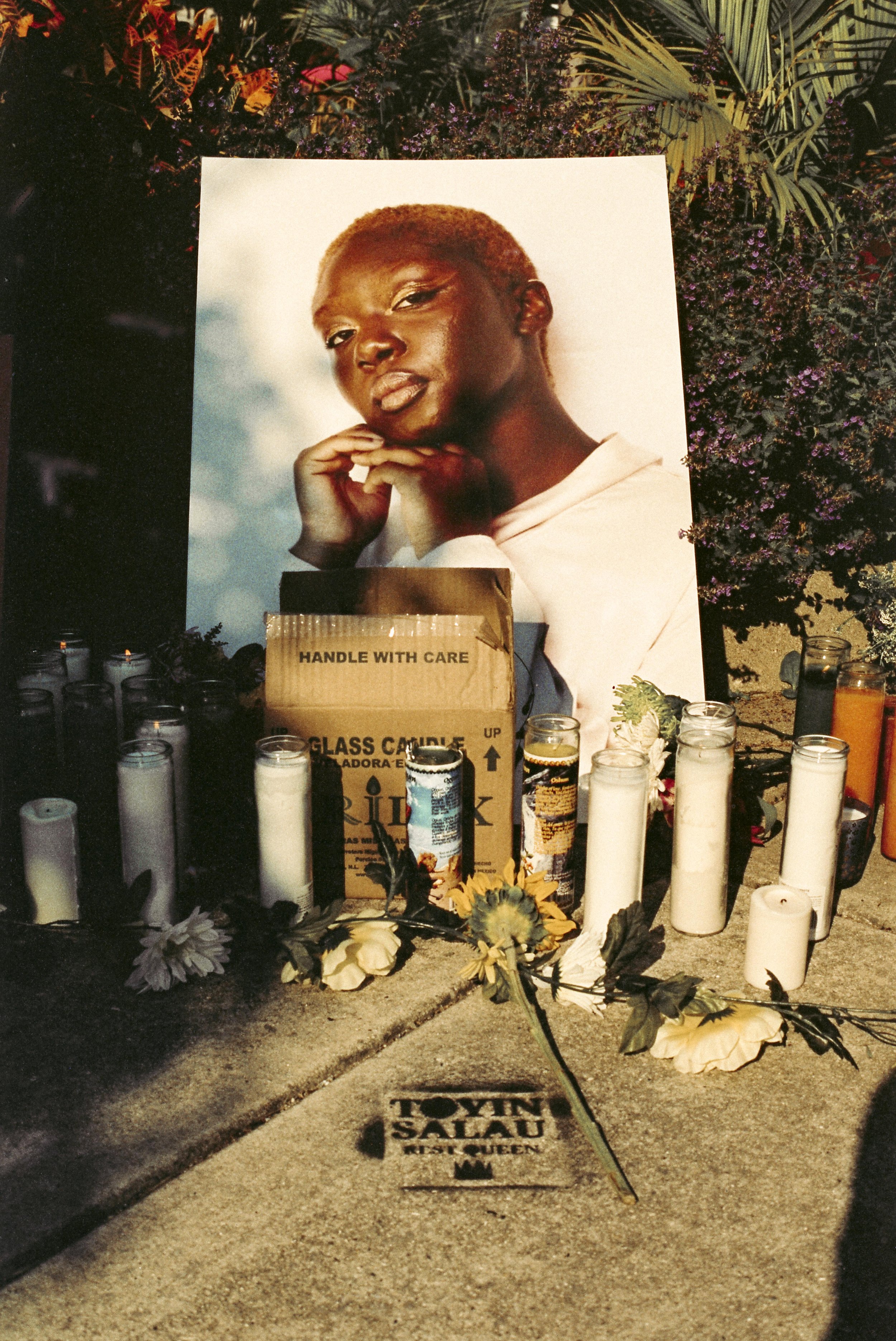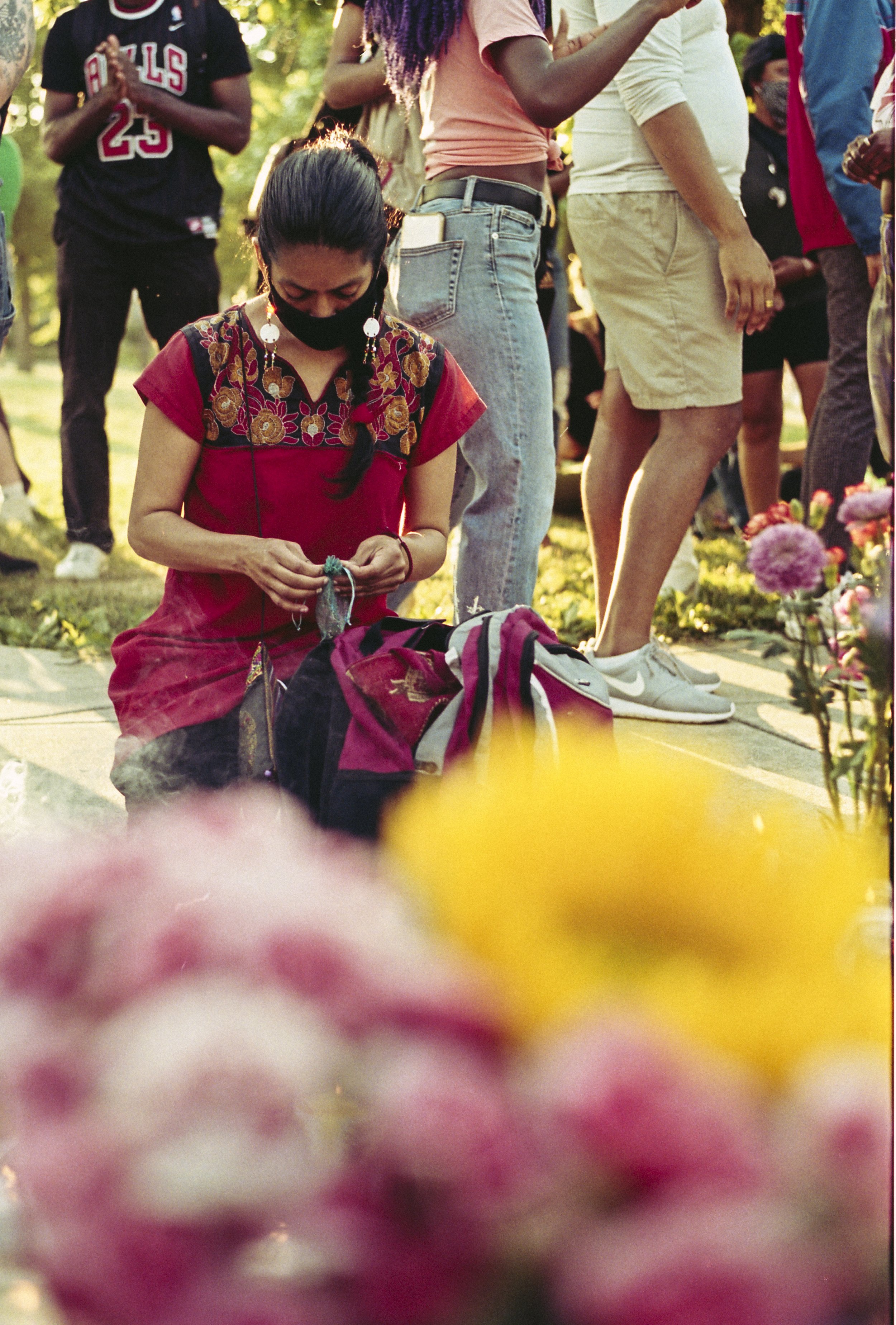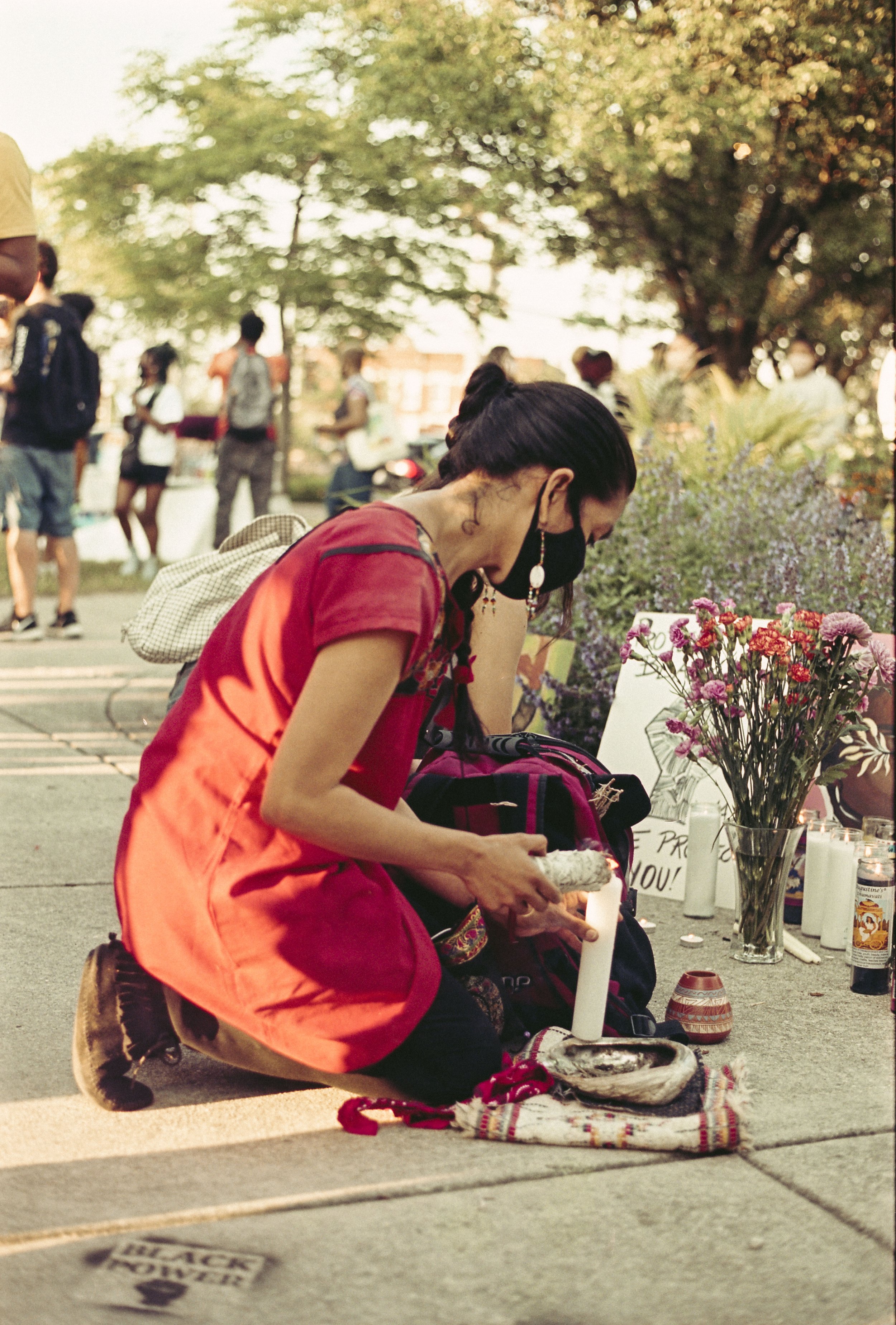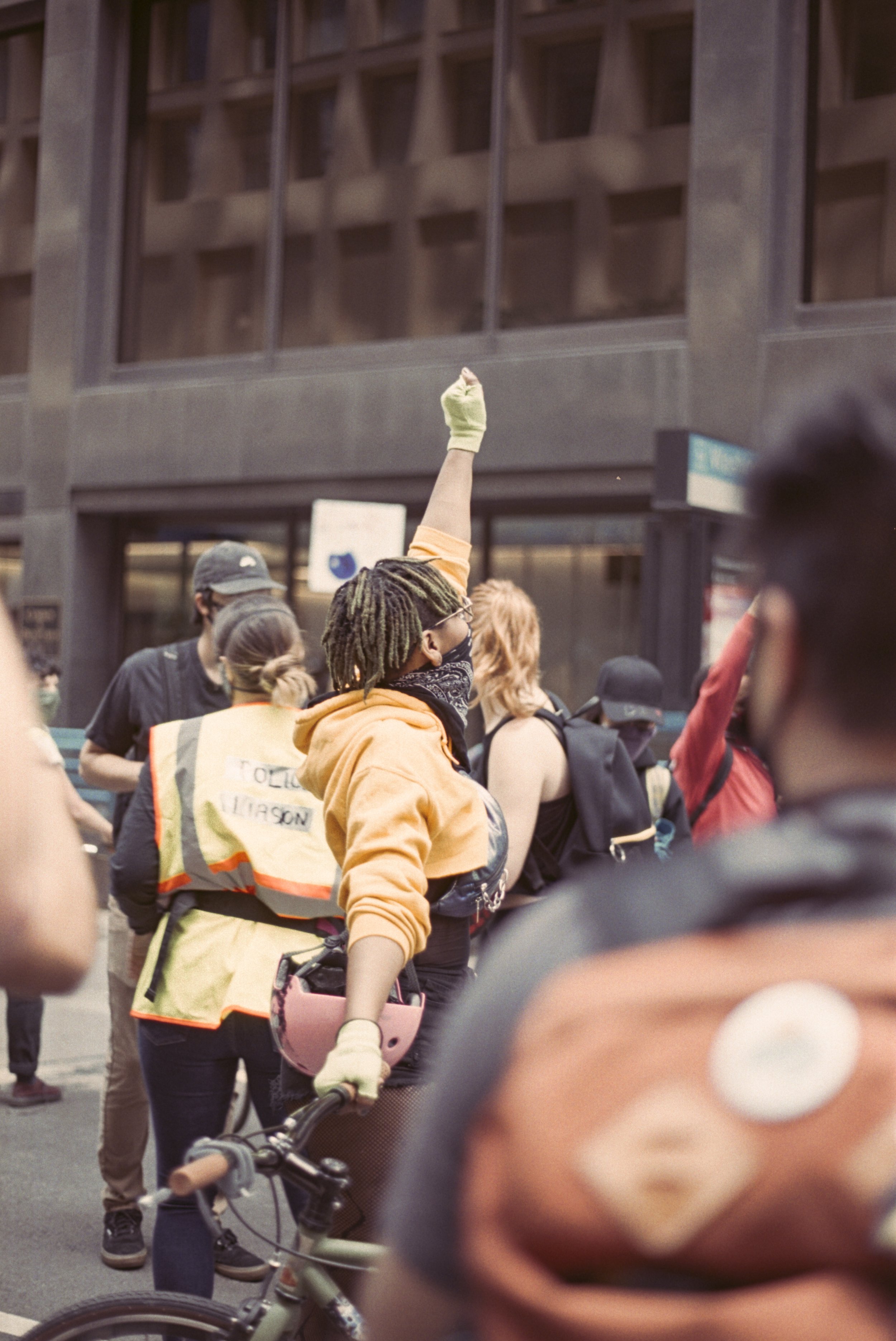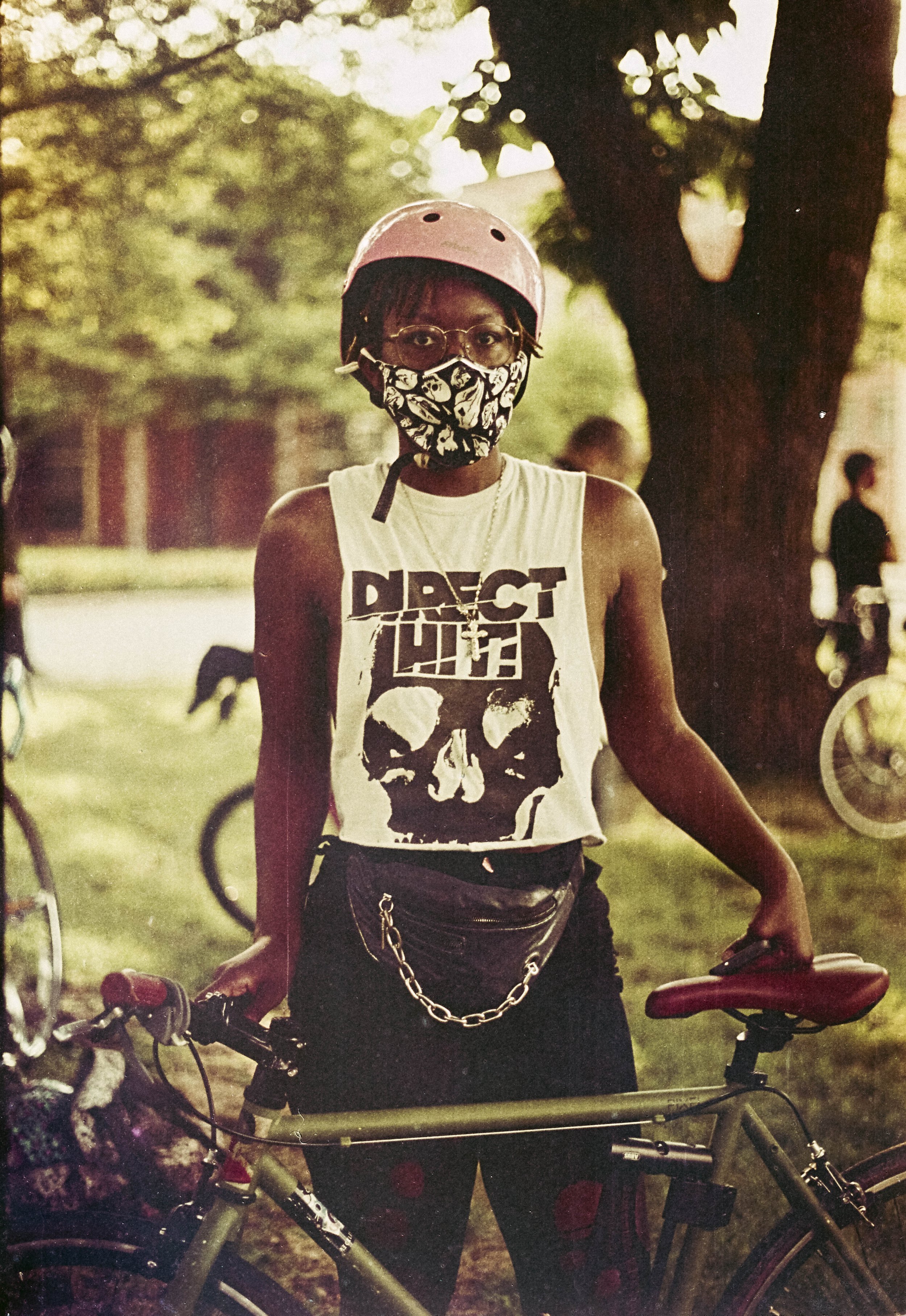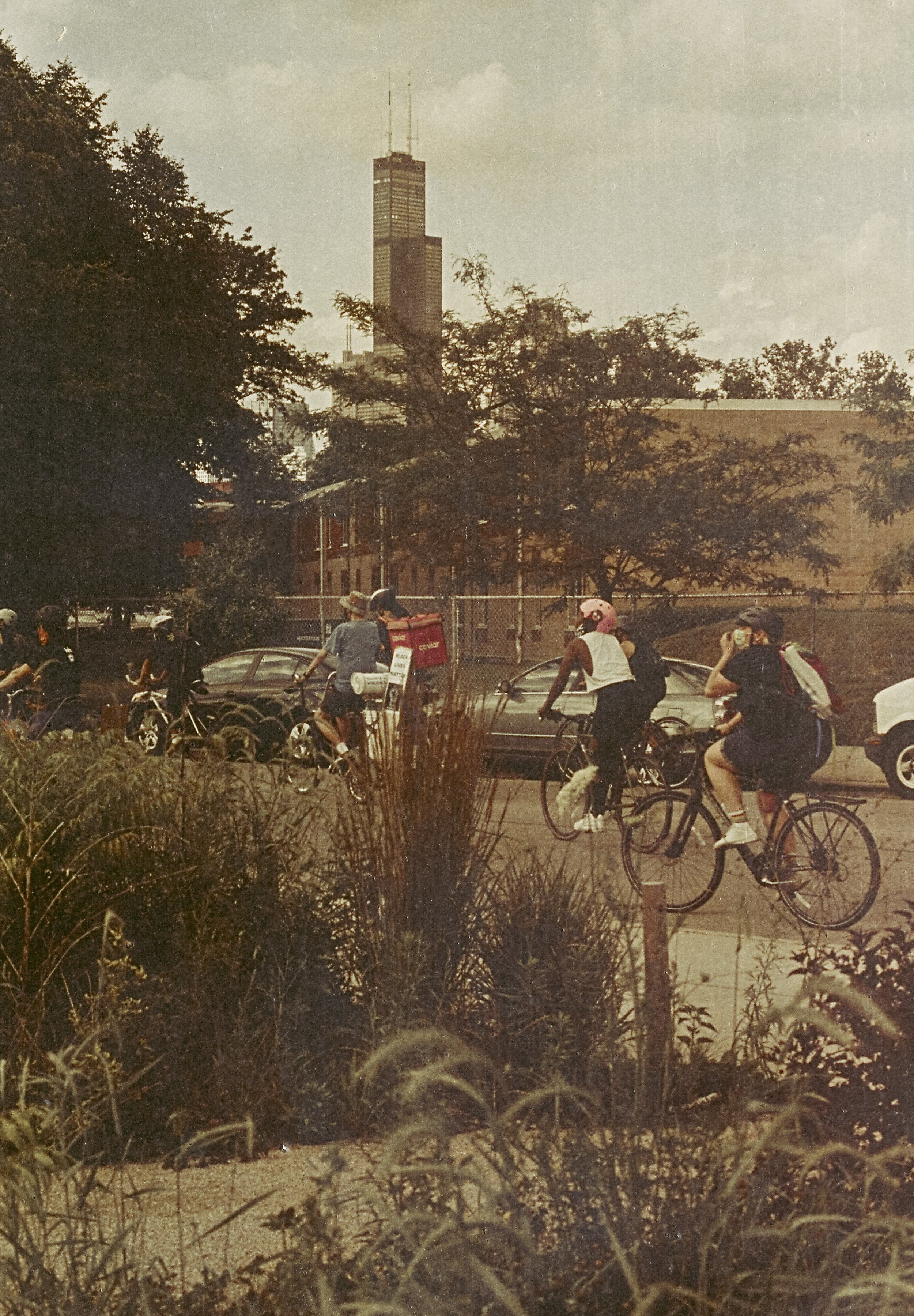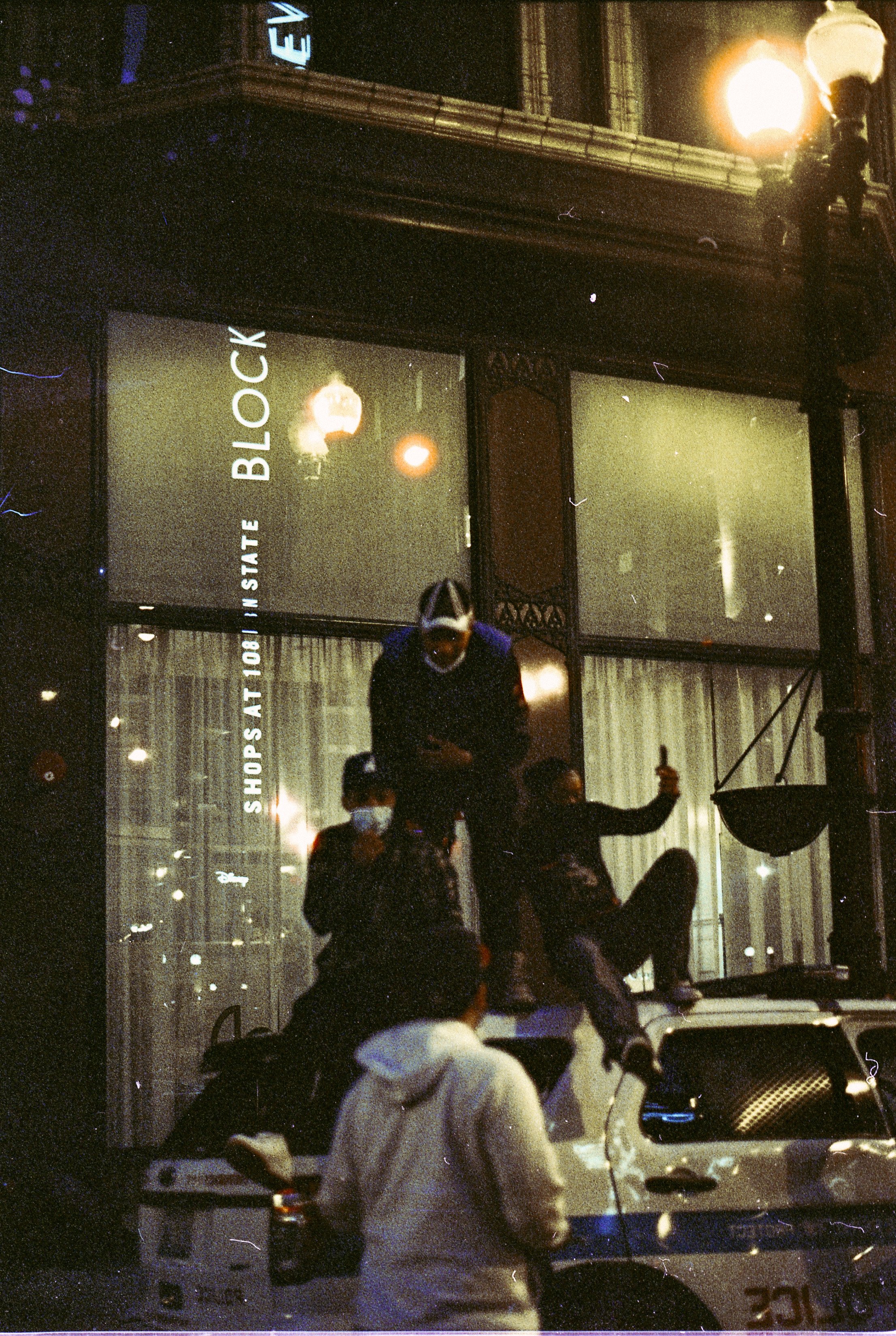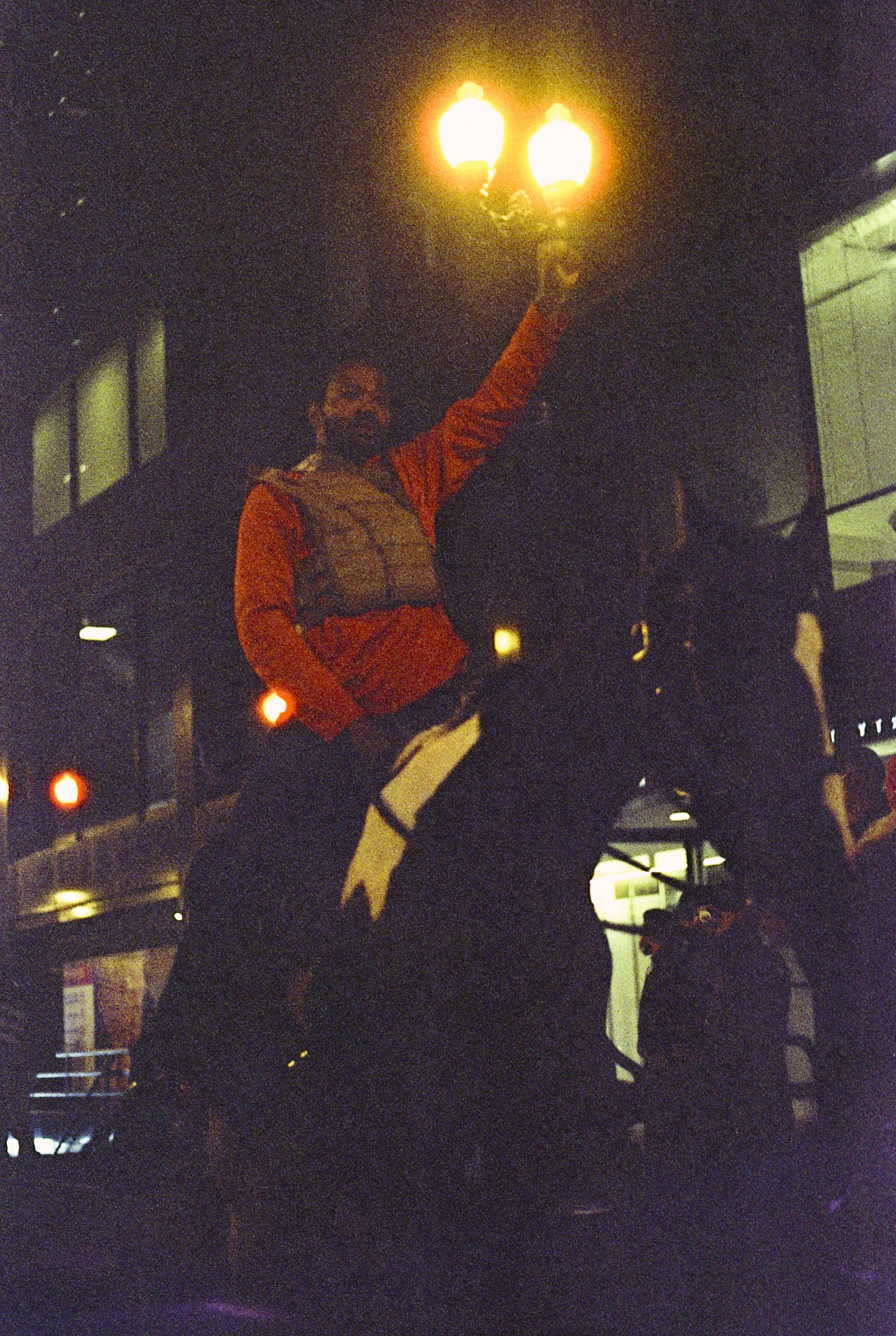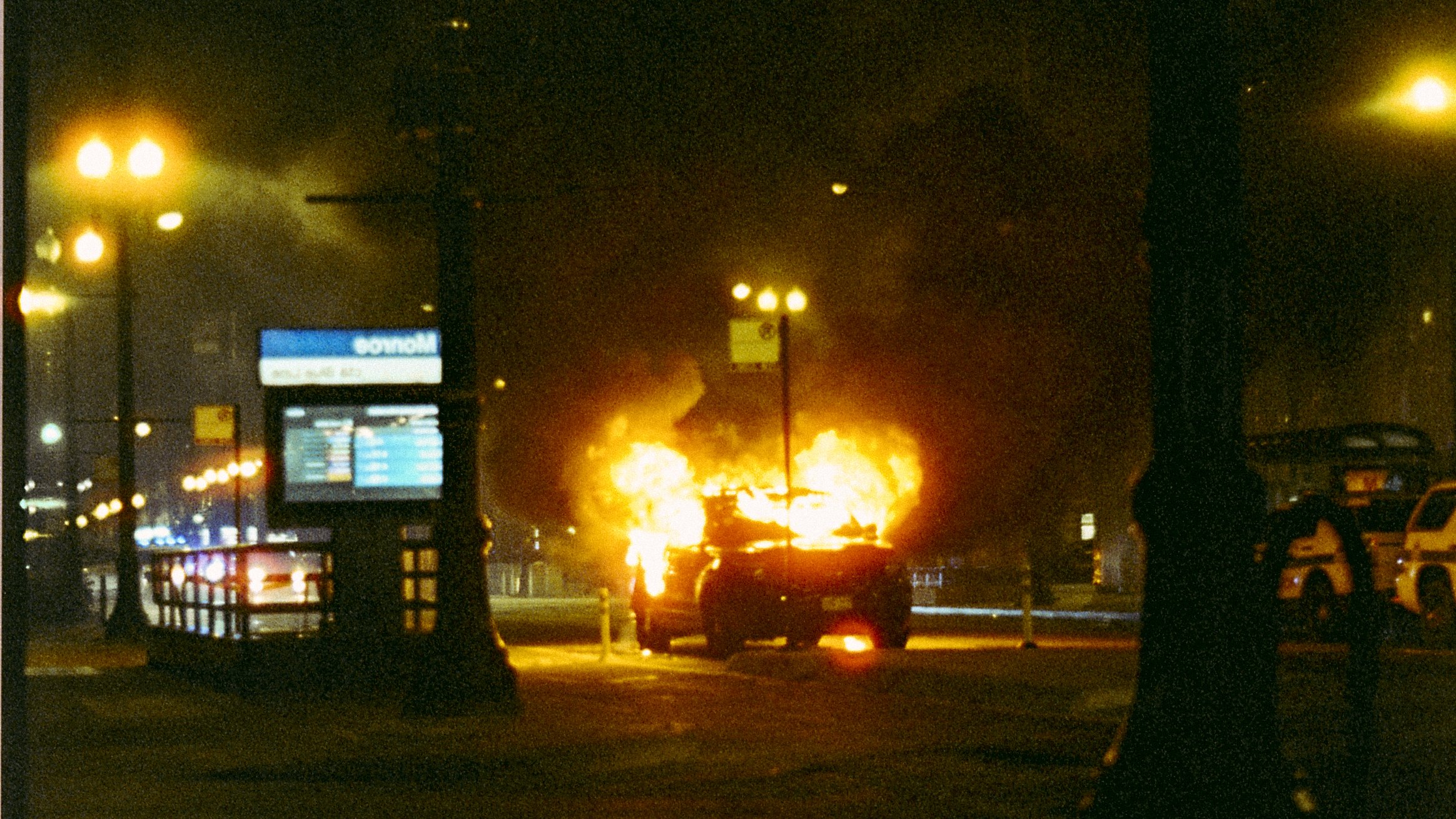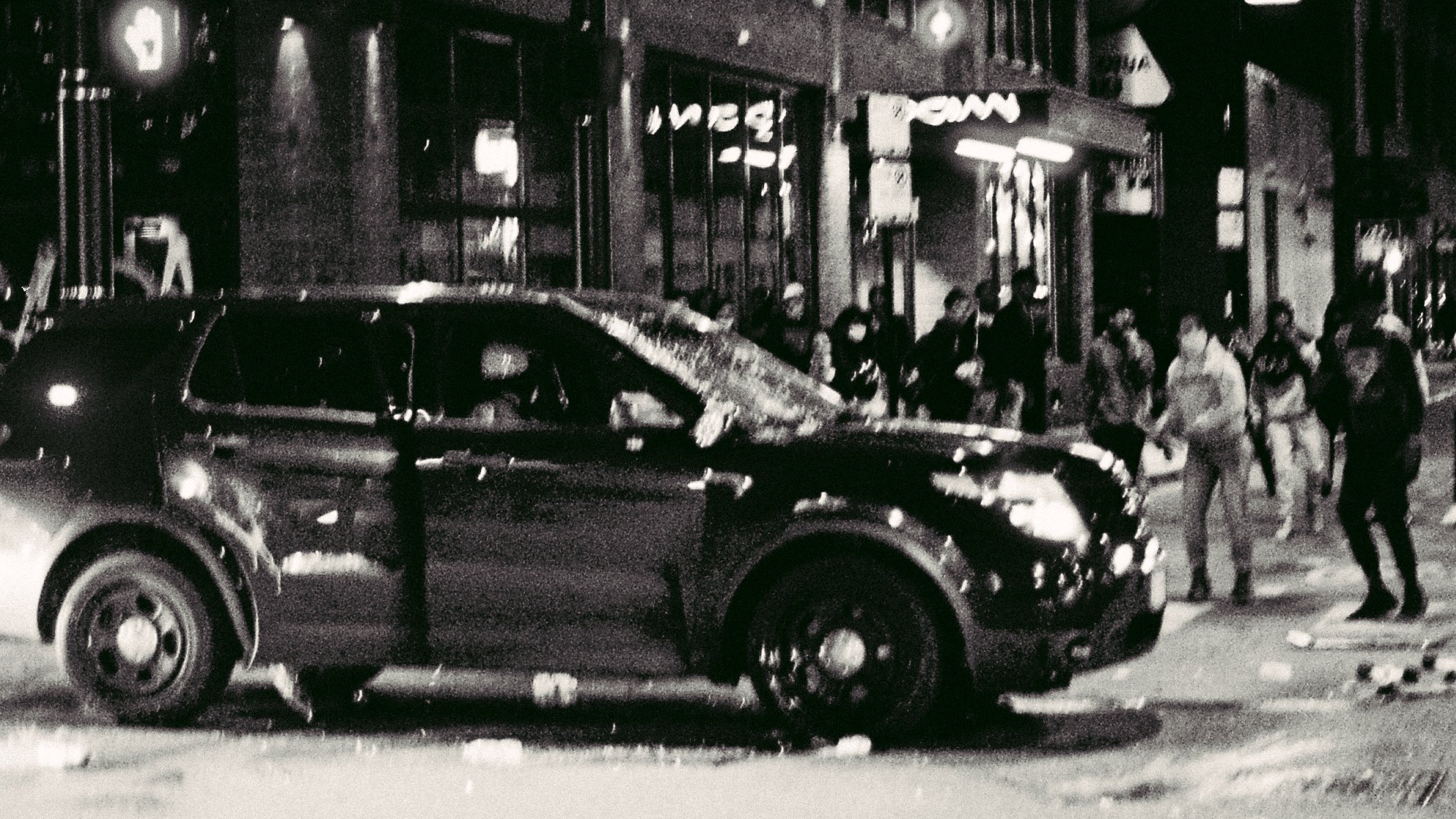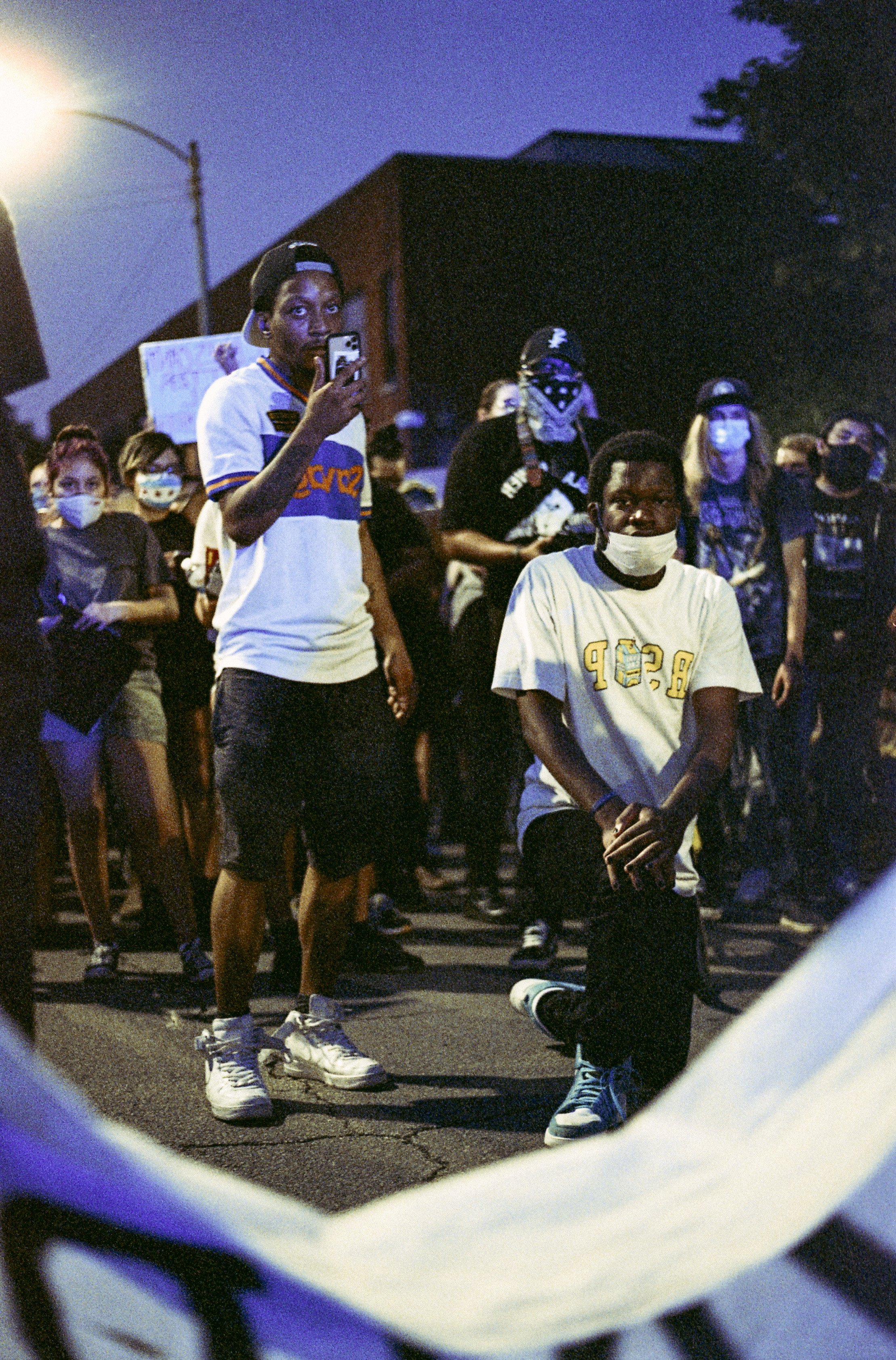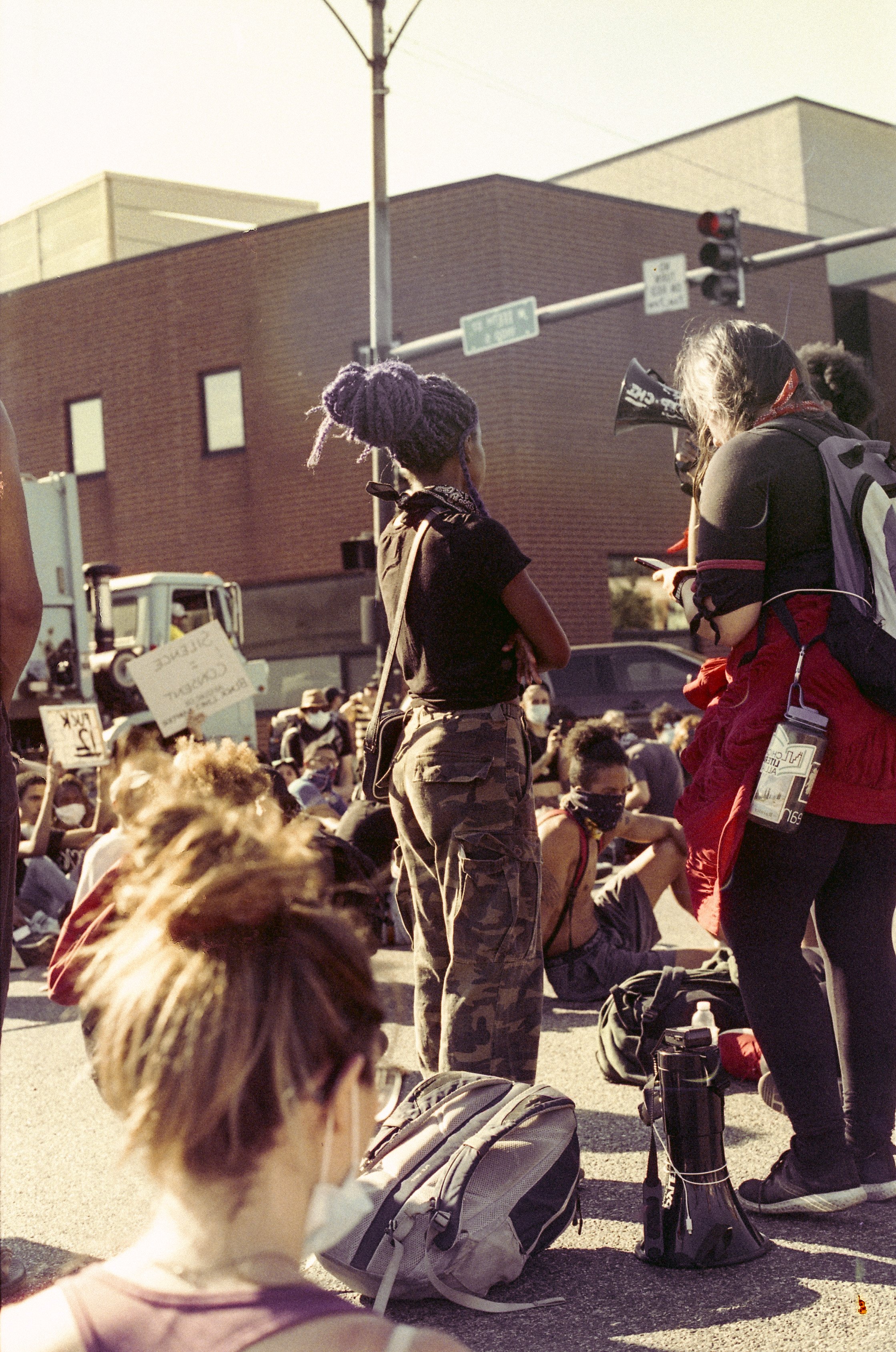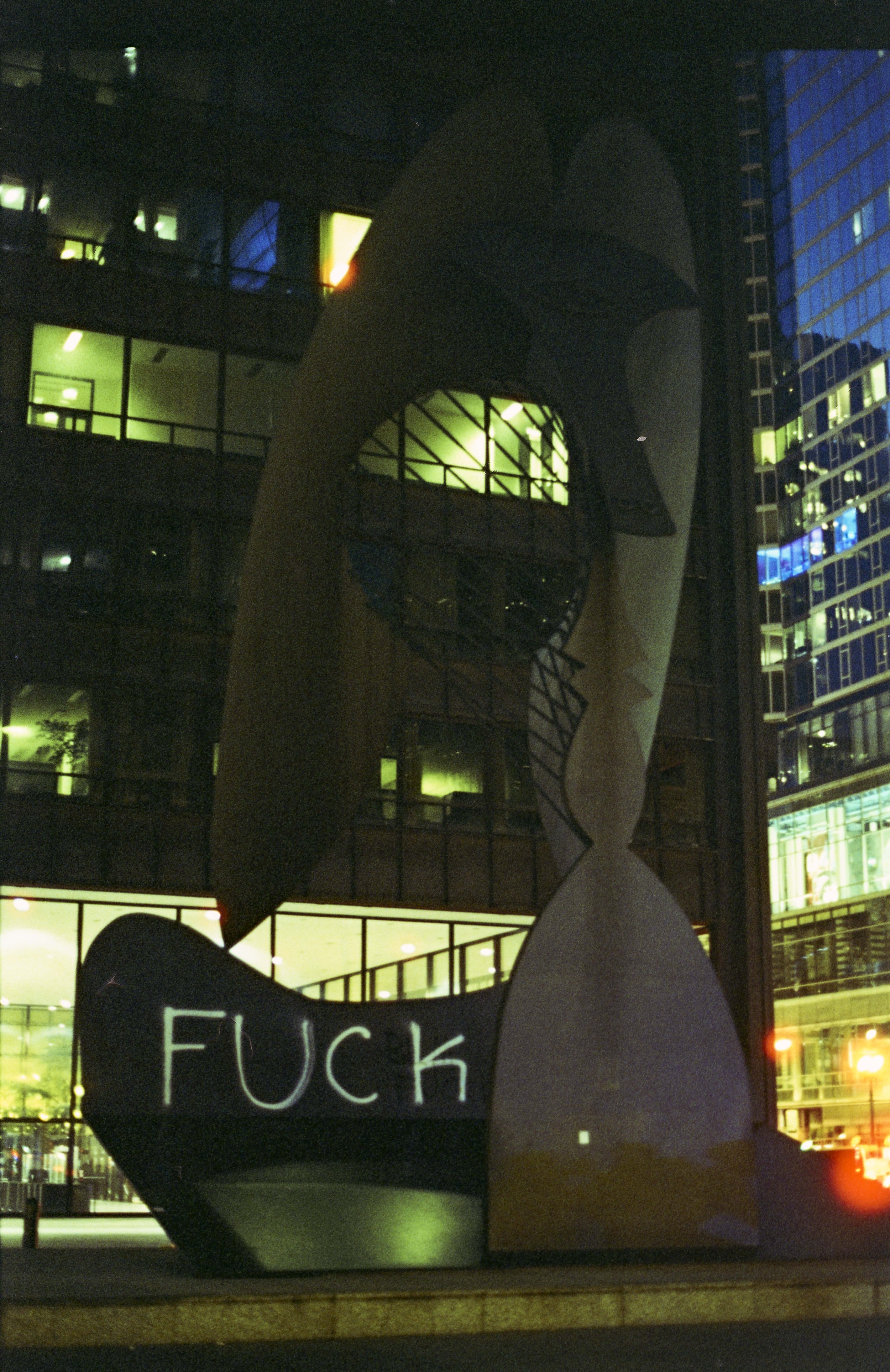BLACK AND INDIGENOUS FUTURES
2022
The future of Black and Indigenous people is one of healing and rebelling for the liberation of the land because the treatment of the land is tethered to the treatment of the bodies, minds, and spirits of all living beings on it.
This photo document series is reflective of the awakening power that emerges from Black and Indigenous resistance movements that I have been a witness to. From youth residing in the urban city of Xicago rising up against police brutality, to the healing environments I found along my journey into learning rebellion. Using these two energies to work in conjunction to establish that healing and anger are one and the same just as Indigenous identity includes Black people.
Through the deconstruction notions of identity in my personal life which lead to the reaffirmation of my Indigeneity, I was guided to seek out the ancestral connections to land that were severed by colonialism.
Once I cut my bound roots from settler colonialism,
I was able to establish my roots into the soil of the land and new worlds opened up.
Worlds that contradict and delegitimize the false homogenized reality of settler colonialism.
It was only after I left the city and built my relationship to farmland that it became apparent to me the trauma that has come from my separation of land and living in the city. It was then that I knew that I was a part of that diasporic project of the displacement of Indigenous people throughout the world. Through understanding history, I can make sense of today. Through history I can understand what our futures can be, it all comes back to us and our relationship to land.
I ask, what is your relationship to land?
My journey started during the BLM uprising on the night of May 29th, 2020 in Xicago. I remember after seeing a friend’s story on social media protesting the murder of George Floyd, I left on my bicycle onto Clark street heading south to downtown Xicago. The time was around 10pm, on my way there, 13 police cars sped past me going 100+Mph. I felt an ominous energy from that scene. I didn’t know yet the anger that was to come from the youth of Xicago after the video release of the murder of George Floyd.
"There but for the grace of God goes Chicago." Lori Lightfoot, said Chicago Mayor the night the video was released.
By the night of the 30th in three days, 1,258 people were arrested, downtown Xicago was covered in smoke from tear gas and the burning of police cars.The city raised the bridges connecting downtown to the mainland cutting access off to the richest part of the city.
The spirit of rebellion simmered throughout the summer but without land the ability to build an alternative way to sustain ourselves outside the logic of capitalism was limited and soon people were tired and traumatized. 2020 ended anticlimactically but I started to see the grietas [cracks]that BLM left throughout the world.
A year after the uprising, in 2021, It wasn’t hard to see how the direct actions polarized Xicago. No one wanted to talk about it, people were avoidant around the topic and the flow of support and money dwindled. During this time the battle to stop the Line 3 pipeline was already underway in northern Minnesota. Stop Line 3, a 2-spirit, queer and Indigenous women led effort to stop Canadian oil conglomerate Enbridge from drilling of the Mississippi River to build a new pipeline; one to replace the older pipeline route that is still falling apart. This would destroy vast ecosystems of Manoomin (wild rice) beds and wildlife in Anishinaabe territory. Another project that has and will keep negatively affecting the lives of Black and Indigenous people through the destruction of land. There was a big call for allies and accomplices with means to make it out to these spaces not only in the spirit of reparations, but to actually use their privilege to push forward Black and Indigenous voices.
The main camp I participated in was Red Lake Treaty Camp, which took a stance against the pipeline by setting up camp next to the drilling site of the Mississippi river. Coming to this prayer camp I was able to share space with other comrades for the first time from different worlds but all shared the common pain of living and participating in these destructive societies. While still having to deal with navigating these spaces with white allies, this camp encouraged BIPOC to take up roles of leadership. Many Black and Indigenous people that came to fight the pipeline also came to heal and find community, to escape the harsh reality of being black and/or indigenous in the Americas, in a society that doesn’t want us to exist with autonomy.
Within these spaces created by this struggle for land, we discussed our dependency on white allies and what their role in the fight for liberation should be. The centering of Black and Indigenous voices and bodies became crucial to me with any liberation/resistance work moving forward. What was learned from sharing our experiences navigating whitel led spaces, is that most often our experiences, lives, voices are not heard but instead get overlooked because of egos, an impediment to black and indigenous liberation.
By the end of 2021, new frontlines were being created, one of them being the Winnemucca Indian Colony in Winnemucca, Nevada. This frontline was created to stop the demolition of indigenous elders' homes and the violent treatment of them to run them off the colony. I came in a day before Valentine’s day. By this time the prayer camp that held it down through the Nevada winter was taken down by the Bureau of Indian Affairs police. Everyone taking part of the camp was arrested and charged, many left and only a handful of supporters stayed. Leading up to arriving at the colony, I was warned by other comrades about the situation. I didn’t know who to believe at that point and had to rely on what my ancestors wanted me to learn from these lands.
I came into uncertainty wondering if my world will be turned upside-down.
I reaffirmed that I needed to be there while looking at the shadow of Sarah Winnemucca casting on the Winnemucca Mountain late afternoon when I first arrived there.
“What I experience here I will take with me towards liberation. ”
With only two supporters, they had a picnic at a public park close by with the elders who lived in the colony. It was the first time I saw all of them together. The generational trauma that Black and Indigenous people face and move through made it hard to move together to fight against a self-appointed council using the BIA as their enforcer to demolish the homes of elders who still live there. With the use of social media to bring attention, we were able to hold them off from demolishing any more homes. As of January 2023, without any supporters on the ground to help protect the elders homes, two of the elders' homes have been set on fire, one of the homes had several dogs killed in the fire. The elders are staying at hotels still trying to get supporters to take back the colony.
There is an evolution happening in resistance work as youth get more involved and find ways to use social media to maneuver resources and mobilize mutual aid networks. As more frontlines appear, our learning of rebellion grows, the better we are able to defend the land and water. The nature of this photo exhibition is traumatic but I try presenting it with a healing light. A narrative that speaks of hope and love for ourselves and our desire to liberate our bodies and the land from the toxicity of settler colonialism.
What is the future of Black and Indigenous Futures?
Whether you are Black and/or Indigenous, our function in this settler society is the same. How we struggle within this society is distinct to one another. as Vine Deloria puts it in his book Custer died for your Sins, for indigenous people
“The problem is and always has been the adjustment of the legal relationship between the Indian tribes and the federal government, between the true owners of the land and the usurpers” And for Black people. “No matter how many Civil Rights laws are passed..the basic thrust is to keep the Black out of society and harmless. The problem, therefore, is not one of legal status, it is one of culture and social and economic mobility.
From seeing the toxicity of colonialism run in my family and many others I love, I understand what our function has been within these societies. Without shame most laws and policies created by eurocentric societies are to remove us from land and exploit our labor. It is the extraction of natural resources and this labor that the capitalist hydra depends on to maintain itself.
Even though not everyone knows about NAFTA, I only know because it affected me and my family. In 1994 the North American Trade Agreement (NAFTA) was implemented. It was a trade agreement between the U.S, Mexico, and Canada, an economic agreement to improve “free” trade between the countries. This would help them be more competitive in the global market against China by eliminating most tariffs when products were made from one of the signing countries. The false illusion was sold to the people of Mexico that NAFTA would bring Mexico and its people into the first world, but the dumping of cheap corn into Mexico devastated many farming villages in Mexico that depended on corn to sustain their traditions and communities. With the dismantling of social programs that were helping to feed the people of Mexico, many families, especially the young people left to the north leaving their rural villages deserted with those who couldn't come. Similar to Operation Iraqi Freedom, NAFTA was freedom for the people of Mexico to be exploited by the free market. Most recently replaced by the United States-Mexico-Canada Agreement (USMCA) on July 1, 2020.
1994, the year that NAFTA was implemented, was the year that my mother and I , along with other relatives, left our village, Zaragoza de La luz, Puebla. We left the lands we were connected to and sustained ourselves by growing food and building relationships with other surrounding villages, to go to the north and give our labor as undocumented immigrants. I was young when I left so I have no memory of my village, only pictures of me walking around my grandmothers house and the stories my mother has told me about the fields of cactus fruits, mango and lime trees my grandfather cultivated, and the many flowers (Celosias, Gomphreys, Dahlias) that grows in my grandmother's garden and on the land. Before NAFTA, my village didn’t make much money from farming but we weren’t going hungry and we had time to practice our village traditions.
Integration into these colonial societies has been the way Black and Indigenous people have survived through the conquest and enslavement that colonialism imposed. The problem now is that as a collective, we are assimilating, learning, and using in practice these settler colonial values to “make it” and play the function to maintain this society. The problem of classism was prominent in the BLM marches with the anti-black and anti-poor rhetoric that came from Black and Brown people that were against the protestors. Another example is Barack Obama, a lot of us were fooled to believe he was going to do better running this mechanism of violence.
In the Winnemucca Indian Colony, there were indigenous people that were sabotaging resistance work and using the space to create clout and swindle money from movements and in this case from the hands of indigenous elders, causing the elders to fight over the money that was being raised to help them. Our own people are learning and are being consumed by the toxicity of settler colonialism, this is causing harm to spaces trying to build spaces of autonomy and resistance to protect the land and the beings living on it.
When there is only one reality that we have lived through, what else would we know? It has been my undocumented status that has kept me from fully participating in this society of borders and laws. Not being able to participate in this illusion that the United States creates helps me to see from the outside looking in the true cost of this freedom and luxury through the violence and trauma it imposes on the people of the world more in particular, Black and Indigenous people and land. Someone born here would most likely not even have to think about life outside the states. Those who participate wants to believe that the U.S is the best country but it’s all build on genocide and a false reality not in harmony with nature. The false comfort and luxury that capitalism provides convinces many like my family that it's the best option we have. Further integration secures our lives but at the cost of losing our humanity and relationship to land in participating in these violent societies. This resonates strongly in my family after living here +25 years since NAFTA got implemented. The most harm has come from the separation of land. Healing with the land becomes the first step to taking back our futures.
How do we heal?
Not many urban Black and Indigenous kids have the privilege to have a relationship with the land. Instead, we are taught to fear nature, and are reminded in schools of the genocide that has taken place on the land.The trauma caused by colonial violence is a weapon used to separate us from the land: the economic foundation of "America" was the exploitation of enslaved Black and Indigenous bodies' land knowledge in farming and the fur trade respectively.
Ultimately, we must heal this trauma of the land imposed by settler colonialism that stops us from seeking a relationship with it.
Black and Indigenous kids raised in urban settings are only exposed to the reality of settler colonialism, a reality of labor extraction through educating us in the fields most useful in the labor force:Math, Science, economics, etc. The Xicago Public Schools have conditioned me to participate in the labor force needed to maintain and extend the power of coloniality throughout the world. Our educational institutions primed me to believe that getting a career was my purpose and the only measure of my worth. It was only when I sought out a relationship with land that I started to heal, feeling my worth through the land. I was no longer tied to the criminalization of my humanity for being undocumented. My commitment to land became my liberation by exposing me to the true reality of the Earth, one in which we are a part of the land: a reality not disconnected from trees and other beings. A reality of multiple truths where wisdom comes from the land.
Healing through the land has been my liberation from the conditioning of settler colonialism. After graduating college in 2015, I decided to leave the city and start volunteering at farms in the midwest on Potawatomi and Menonminee territory. I saw the healing that was taking place in me from building a relationship with the land. Even if the lands I visited and put labor into were privatized and owned by white people, the re-introduction to the land radicalized me. This relationship that I began to have with the land is why, today, I still seek to find land to commit myself to. Through this relationship, I am able to understand land wisdom and connect to my ancestors, who also understood this constant effort to be in harmony with nature and all beings. To this day, I still continue to develop my relationship with land in hopes that I can contribute to a community through my love of the land. At the moment, the only land I have been able to commit myself to has been a farm called Peaceful Farm, located west of Madison, WI. A professor of mine asked me to help him establish this farm of 14 acres on land depleted from the industrial agriculture practices used to grow corn. Our purpose in growing food is to put organic produce into low-income communities, while at the same time using practices for restoring the soil’s health. It is the only land I have access to where my labor feels impactful and long lasting for the generations that will be able to enjoy the baby oak trees I plant today. Being connected to land in this manner makes me feel that I am part of something greater than myself, greater than my individual existence, death no longer becomes a barrier or something to fear. Many ideas and values like these can be found through land that contradict western philosophy’s binary approach to truth, our minds and bodies.
Through land, we can build communities sustained by love drawn from our labor and relationship to land. Creating these land environments for Black and Indigenous kids to heal and to be protected from indoctrination into the patriarchy could be the beginning to securing our futures. This radicalization through the land is already happening throughout Xicago. Black and Indigenous youth in the city are beginning to seek that relationship with land, which first involves listening to and understanding what the land wants from us. There is a future for us, if we are able to mend our relationship with land and heal our traumas.
My upcoming solo exhibition is in September 29 2023 Xicago
IG: _Indio___
Akira:Light that heals
Zuiko Media
Luzdeindio.com




























